Thrane and Thrane A S 6216 Sailor 6216 VHF Transceiver with DSC class D User Manual SAILOR6216UM
Thrane & Thrane A/S Sailor 6216 VHF Transceiver with DSC class D SAILOR6216UM
manual
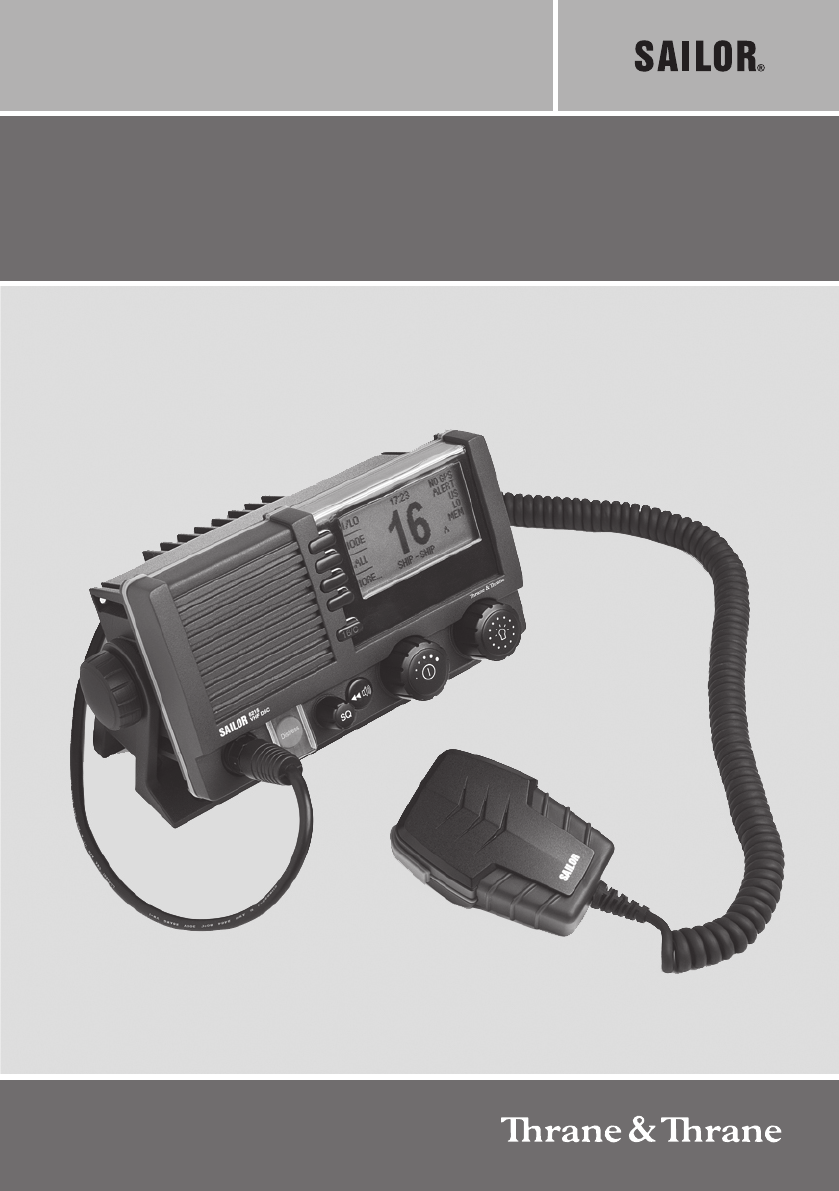
USER & INSTALLATION MANUAL
SAILOR 6216 VHF DSC
Thrane & Thrane A/S
SAILOR 6216 VHF DSC Radio
User and installation manual
Document number: TT98-128825-THR-C
Release date: January 8, 2010
Disclaimer
Any responsibility or liability for loss or damage in connection with the use of this
product and the accompanying documentation is disclaimed by Thrane & Thrane. The
information in this manual is provided for information purposes only, is subject to
change without notice and may contain errors or inaccuracies.
Manuals issued by Thrane & Thrane are periodically revised and updated. Anyone
relying on this information should acquire the most current version e.g. from the Thrane
& Thrane Extranet at: http://extranet.thrane.com.
Thrane & Thrane is not responsible for the content or accuracy of any translations or
reproductions, in whole or in part, of this manual from any other source.
Copyright
© 2010 Thrane & Thrane A/S. All rights reserved. Printed in Denmark.
Trademark Acknowledgements
•SAILOR is a registered trademarks of Thrane & Thrane A/S.
• Other product and company names mentioned in this manual may be trademarks or
trade names of their respective owners.

iii
Safety warning 1
The following general safety precautions must be observed during all
phases of operation, service and repair of this equipment. Failure to comply
with these precautions or with specific warnings elsewhere in this manual
violates safety standards of design, manufacture and intended use of the
equipment. Thrane & Thrane assumes no liability for the customer's failure
to comply with these requirements.
Warranty limitation
IMPORTANT - The radio is a sealed waterproof unit (classified IPX8). To
create and maintain its waterproof integrity it was assembled in a controlled
environment using special equipment. The radio is not a user maintainable
unit, and under no circumstances should the unit be opened except by
authorized personnel. Unauthorized opening of the unit will invalidate the
warranty.
Installation and service
Installation and general service must be done by skilled service personnel.
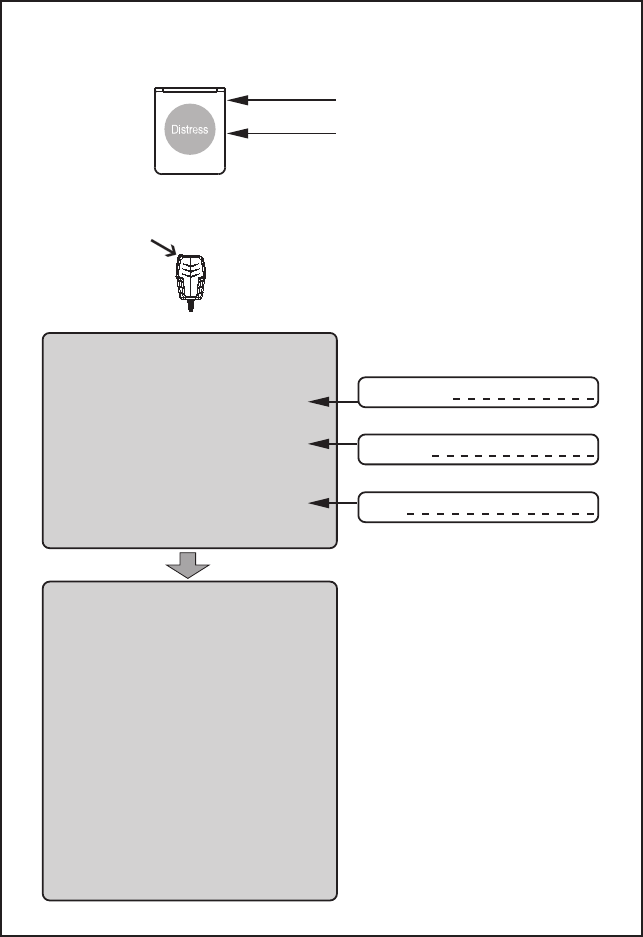
iv
Emergency calls
MM
MM
MAA
AA
AYY
YY
YDD
DD
DAA
AA
AYY
YY
Y
NANA
NANA
NAMEME
MEME
ME of the VV
VV
VEE
EE
ESS
SS
SSS
SS
SELEL
ELEL
EL in distress
CC
CC
CALAL
ALAL
ALLL
LL
LSS
SS
SIGNIGN
IGNIGN
IGN or other IDENIDEN
IDENIDEN
IDENTT
TT
TIFICIFIC
IFICIFIC
IFICAA
AA
ATT
TT
TIONION
IONION
ION
MM
MM
MMM
MM
MS
S
SS
SII
II
I
(If the initial alert is sent by DSC)
PP
PP
POO
OO
OSS
SS
SITIT
ITIT
ITIONION
IONION
ION
given as ll
ll
latat
atat
atitit
itit
itudeude
udeude
ude and longitlongit
longitlongit
longitudeude
udeude
ude
or
If latitude and longitude are not known
or if time is insufficient,
in relation to a known geographical location
NANA
NANA
NA
TURETURE
TURETURE
TURE of distress
Kind of AA
AA
ASS
SS
SSS
SS
SII
II
ISS
SS
STT
TT
TANCANC
ANCANC
ANCEE
EE
E required
Any other useful INFINF
INFINF
INFOROR
OROR
ORMM
MM
MAA
AA
ATT
TT
TIONION
IONION
ION
MM
MM
MAA
AA
AYY
YY
YDD
DD
DAA
AA
AYY
YY
Y-M-M
-M-M
-MAA
AA
AYY
YY
YDD
DD
DAA
AA
AYY
YY
Y-M-M
-M-M
-MAA
AA
AYY
YY
YDD
DD
DAA
AA
AYY
YY
Y
This is
NANA
NANA
NAME-NAME-NA
ME-NAME-NA
ME-NAME-NAME-NA
ME-NAME-NA
ME-NAMEME
MEME
ME
CC
CC
CALAL
ALAL
ALLL
LL
LSS
SS
SIGNIGN
IGNIGN
IGN
or other IDENTIFICATION
MM
MM
MMM
MM
MSS
SS
SII
II
I
(If the initial alert is sent by DSC)
Use the HANDMICHANDMIC
HANDMICHANDMIC
HANDMICRR
RR
ROPOP
OPOP
OPHONE HONE
HONE HONE
HONE for voice calling
MM
MM
Makak
akak
ake sure sur
e sure sur
e sure e
e e
e youryour
youryour
your
VV
VV
VHFHF
HFHF
HF R R
R R
Radiadi
adiadi
adio o
o o
o ii
ii
is on Cs on C
s on Cs on C
s on CH1H1
H1H1
H166
66
6
LL
LL
Lifif
ifif
ift Ct C
t Ct C
t Covov
ovov
overer
erer
er
PP
PP
Prr
rr
ree
ee
ess
ss
ss RED Buttons RED Button
s RED Buttons RED Button
s RED Button
until acoustic and light-indication
becomes steady (more than 3 seconds)
SHIP‘s NAME:
CALLSIGN:
MMSI:
OWN OWN
OWN OWN
OWN IDID
IDID
ID
99-129558

v
Training information 2
The Sailor 6216 VHF radio is designed for "occupational use only"
and is also classified as such. It must only be used in the course of
employment by individuals aware of both the hazards as well as
the way to minimize those hazards
The radio is thus NOT intended for use in an uncontrolled
environment by general public. The Sailor 6216 has been tested
and complies with the FCC RF exposure limits for "Occupational
Use Only". The radio also complies with the following guidelines
and standards regarding RF energy and electromagnetic energy
levels including the recommended levels for human exposure:
• FCC OET Bulletin 65 Supplement C, evaluating compliance with
FCC guidelines for human exposure to radio frequency
electromagnetic fields.
• American National Standards Institute (C95.1) IEEE standard for
safety levels with respect to human exposure to radio frequency
electromagnetic fields, 3 kHz to 300 GHz
• American National Standards Institute (C95.3) IEEE
recommended practice for the measurement of potentially
hazardous electromagnetic fields - RF and microwaves.
Below the RF exposure hazards and instructions in safe operation
of the radio within the FCC RF exposure limits established for it are
described.
Warning
Your Thrane & Thrane radio set generates electromagnetic RF
(radio frequency) energy when it is transmitting. To ensure that
you and those around you are not exposed to excessive amounts of
that energy (beyond FCC allowable limits for occupational use) and
thus to avoid health hazards from excessive exposure to RF
energy, FCC OET bulletin 65 establishes an Maximum Permissible
Exposure (MPE) radius of 3' (0.9m) for the maximum power of your
radio (25W selected) with an half wave omni-directional antenna
having a maximum gain of 3 dB (5.2dBi). This means all persons

vi
must be at least 3' (0.9m) away from the antenna when the radio is
transmitting.
Installation
1. An omni-directional antenna with a maximum power gain of
5.2 dBi must be mounted at least 9.6' (2.9m) above the highest
deck where people may be staying during radio transmissions.
The distance is to be measured vertically from the lowest point
of the antenna. This provides the minimum separation distance
which is in compliance with RF exposure requirements and is
based on the MPE radius of 3' (0,9m) plus the 6.6' (2m) height
of an adult.
2. On vessels that cannot fulfil requirements in item 1, the antenna
must be mounted so that its lowest point is at least 3' (0.9m)
vertically above the heads of people on deck and all persons
must be outside the 3' (0.9m) MPE radius during radio
transmission.
• Always mount the antenna at least 3' (0.9m) from possible
human access.
• Never touch the antenna when transmitting
• Use only authorized T&T accessories.
3. If antenna has to be placed in public areas or near people with
no awareness of the radio transmission, the antenna must be
placed at a distance not less than 6' (1.8m) from possible
human access.
Failure to observe any of these warnings may cause you or other
people to exceed FCC RF exposure limits or create other dangerous
conditions

vii
Manual overview
This manual has the following chapters:
• Introduction contains a description of the VHF radio.
•Operation explains how to make and receive VHF and DSC calls,
including how to use and set-up the channel scanning, the 2-
way loudhailer, fog horn external loudspeaker.
•Installation explains how to mount the VHF radio and how to
connect accessories and external equipment.
•Service & maintenance contains support information including
lists of accessories and a troubleshooting guide.

viii

ix
Table of Contents
Chapter 1 Introduction
VHF radio with DSC ............................................................ 1
Chapter 2 Operation
General use and navigation ...............................................6
VHF radio communication .................................................12
HI/LO transmission power ................................................ 18
Watch ................................................................................19
Scan .................................................................................20
Radio setup ......................................................................22
DSC calls ..........................................................................25
Phone book .......................................................................41
Loudhailer with talk-back .................................................44
Automatic foghorn ...........................................................45
Hailer and Fog horn setup ................................................ 47
Replay function ................................................................48
Chapter 3 Installation
Unpacking the SAILOR 6216 VHF DSC ...............................49
Installing the VHF radio ....................................................50
Power, VHF antenna and external equipment ..................57
System setup ....................................................................62
SAILOR 6201 Handset cradle (optional) .............................64

Table of Contents
x
Chapter 4 Service & maintenance
Contact for support ...........................................................65
Maintenance ....................................................................65
Equipment and accessories .............................................. 71
Warranty .......................................................................... 71
App. A Technical specifications
App. B Maritime channels
Glossary ......................................................................................... 81
Index .........................................................................................83
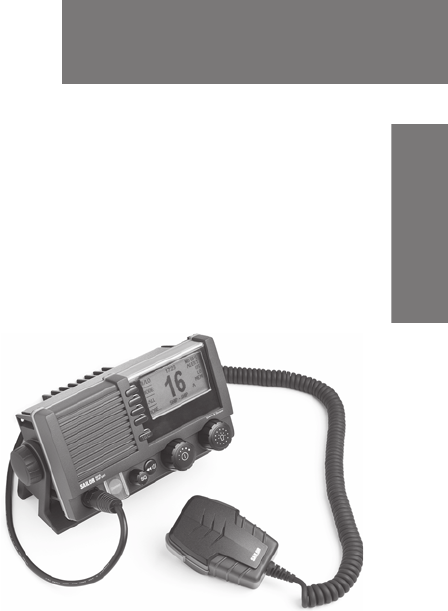
1
Chapter 1
1111
Introduction
Introduction 1
VHF radio with DSC
SAILOR 6216 VHF DSC, your
new SAILOR VHF radio with
full DSC functionality, is
approved to FCC and
Industry Canada and is
waterproof to the IPx8 and
IPx6 standard. As part of the
required safety equipment,
use the SAILOR 6216 VHF
DSC in an emergency
situation. However the best
way to guarantee
functionality in an
emergency situation, is to use the radio in daily communication on board.
The VHF radio is a simplex/semi duplex VHF radio. It is designed with an easy-
to-use menu-driven setup. You use the soft-keys to enter the desired
functions, you browse and select a setting using the right selection wheel
knob. The large display has red adjustable backlight which provides a good
visibility even at night and protects your night vision.
The VHF radio can replay the last 90 s of received voice. This is a useful
feature to minimize misunderstandings and to record messages when the
radio is unattended.
The VHF radio connects easily to external equipment like a 2-way loudhailer
and an external speaker. You can use the loudhailer as a 2-way on-board
communicator. The loudhailer also functions as a fog horn. You can select
from several programmed fog-horn patterns.
For a list of other accessories available for the SAILOR 6216 VHF DSC check
with your nearest distributor.

Chapter 1: Introduction
2 VHF radio with DSC
Controls on the front plate
1. Loudspeaker.
2. Four soft keys with function title in the display.
3. Quick selection key for channel 16 and the programmed preference
channel.
4. Large display.
5. Connector for Handmicrophone or handset.
6. Button for sending a DSC Distress alert.
7. Squelch control to mute background noise.
8. Replay button to play back up to 90 s voice message.
9. Volume wheel knob with key-press function for volume control and power
on/off.
10. Selector wheel knob with key-press function for changing the working
channel, navigating in menus in the display and backlight dimming.
2
13 4
6
57 9 10
8

Chapter 1: Introduction
VHF radio with DSC 3
1111
Introduction
SAILOR 6216 VHF DSC display
The picture shows the display
after start-up. The display holds
various fields of information,
depending on the currently
selected function.
1. Action line containing
information relevant for the
currently selected function.
2. Current working channel.
3. Functions you can select with the soft keys. If there are more than 3
functions in the list press the soft key MORE to display further functions.
4. Status and other values for the current state or VHF channel.
5. Service line containing current temporary information relevant for the
current channel or function.
For a detailed description of the information shown for each of the functions
available see the chapter Operation on page 5.
1
2
3
4
5
WATCH
CALL
US
DISTRESS/CALL
16
GPS Position
HI/LO
MORE...

Chapter 1: Introduction
4 VHF radio with DSC

5
Chapter 2
2222
Operation
Operation 2
In this chapter you find detailed instructions and guidelines for:
•General use and navigation
•VHF radio communication
•HI/LO transmission power
•Watch
•Scan
•Radio setup
•DSC calls
•Phone book
•Loudhailer with talk-back
•Automatic foghorn
•Replay function
Note
Before using the VHF radio make sure that the VHF antenna, power
and other external equipment are connected properly. For
instructions see chapter Installation on page 49.
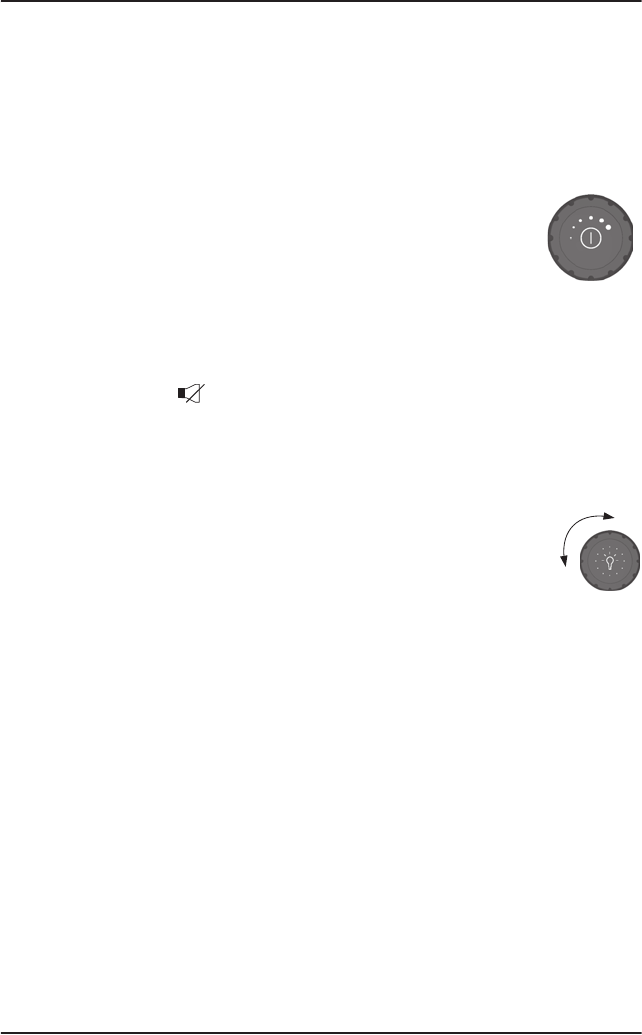
Chapter 2: Operation
6 General use and navigation
General use and navigation
Power on and speaker volume
The VHF radio has a dual-function on/off wheel knob for power
on/off and volume control.
• To power on the VHF radio press the on/off wheel knob.
• To power off the VHF radio, press and hold the on/off wheel
knob and follow the instructions in the display.
• To adjust the speaker volume, turn the volume wheel knob (clockwise =
louder, counter clockwise = softer, until muted). When adjusted to the
muted level is shown in the display.
Working channel, settings and dim function
The selector wheel knob has several functions:
• To select the working channel, turn the selector wheel knob.
• To browse and select settings, turn the selector wheel knob
and press for accept.
•To dim the backlight in the display until it is appropriate for the current
situation, i.e. to give comfortable night vision, press, hold and turn the
selector wheel knob (clockwise= more light).
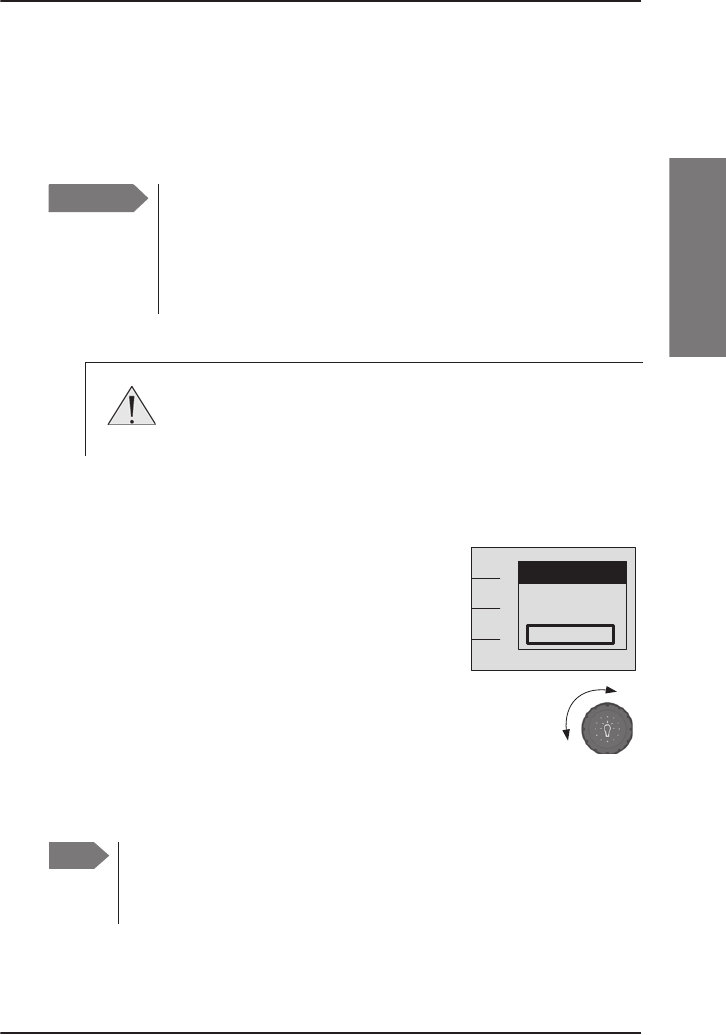
Chapter 2: Operation
General use and navigation 7
2222
Operation
DSC and MMSI number
When the VHF radio is powered on for the first time, you must enter the
vessel’s MMSI number. Hereafter the MMSI number is briefly displayed after
power up. The MMSI is a unique, 9-digit identifier assigned to your ship.
Entering the MMSI number
When being prompted after power up enter the MMSI
number as described below:
1. Enter the 9 digits one by one by turning the
selector wheel knob to the desired digit, press the
selector wheel knob to accept the digit and
advance to the next digit.
To delete the previous digit press the soft key
BACK.
2. Press the soft key OK to confirm the entered MMSI number.
3. To leave without saving press the soft key CANCEL.
Important
The MMSI number must be programmed into the VHF radio to
use any DSC functionality. The radio will prompt for the MMSI
number at each power-up until the MMSI has been entered. An
error message is displayed when trying to initiate any DSC
function. However, you can use the radio in normal VHF mode.
Caution! Without a programmed MMSI number the
Distress button will not work!
Note
The MMSI number can be programmed by the operator once. If a
wrong number has been entered and stored, or if there is a
requirement to change it, contact your authorized dealer.
OK
BACK
CANCEL
No DSC/Distress
Enter MMSI:
MMSI MISSING
000000000

Chapter 2: Operation
8 General use and navigation
Once programmed, you can see the MMSI number
in the service line directly after start-up. The DSC
functionality is operational at any time.
The message NO DSC (NO MMSI) is shown in the
action line if the MMSI is not programmed.
Position and MMSI Information
To display position and MMSI information for the SAILOR 6216 VHF DSC radio,
do as follows:
1. Press the soft key POS. If it is not in the display, press the soft key MORE
until POS appears.
The display shows the current (latest) position (if a GPS is connected), the
position UTC and type, GPS Status and MMSI.
2. You can enter the position and UTC manually. Turn the selector wheel knob
to select the value you want to change. Then press and turn the selector
wheel knob to enter the current position or UTC time. The display shows
Man Position.
3. Press the soft key SAVE to save the new value.
4. After you have entered a value manually or overruled the GPS input, a soft
key UseGPS appears in the display if the GPS is available. Press this soft key
if you decide to use the data from the connected GPS.
5. Press the soft key EXIT to return to normal use.
If the GPS was present and then disappears a warning appears in the display
after 10 minutes. Follow the instructions on the screen.
16
HI/LO
WATCH
CALL
MORE
INT
MMSI NUMBER
219830067
GPS Position
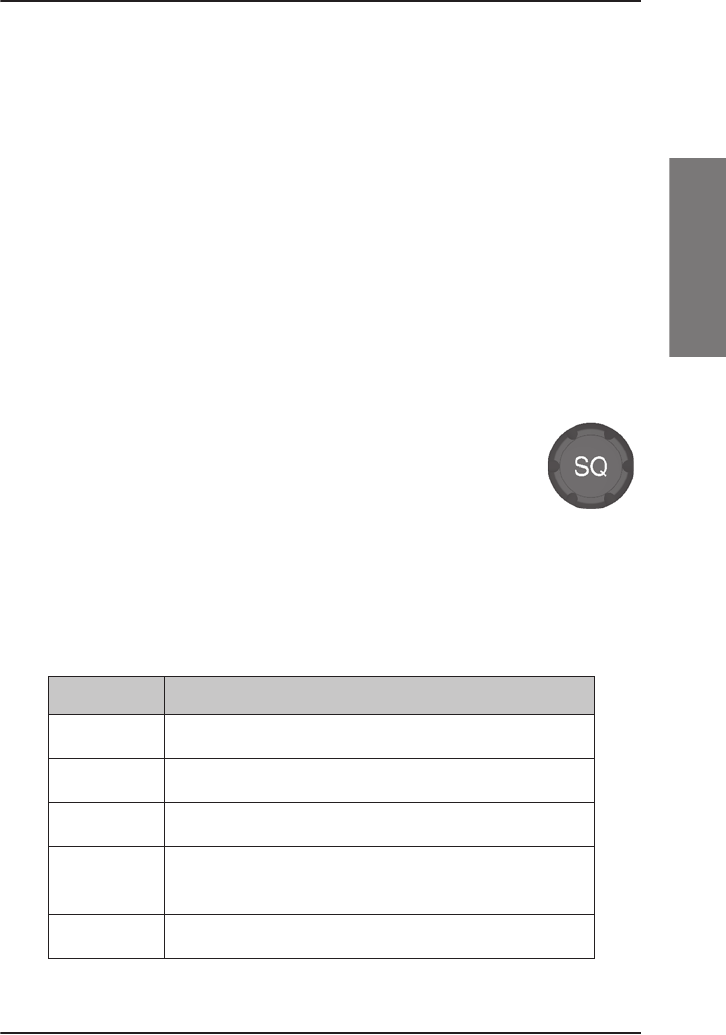
Chapter 2: Operation
General use and navigation 9
2222
Operation
Speaker devices
The VHF radio can be equipped with the following speaking devices:
• SAILOR 6202 Handmicrophone with a PTT (Push To Talk) button.
• Handset with a microphone, ear piece and a PTT button. The volume in the
ear piece can be adjusted, for details see Controller setup on page 10.
• Loudhailer.
•External speaker.
See Controller setup on page 10 for managing speaking devices.
Adjusting the squelch
With the Squelch control you can manually adjust and suppress
noise in order to optimize the quality of the received radio
communication.
• When hearing noise or an unwanted signal, turn the
squelch button clockwise until the speaker is muted.
Functions
The following functions are available from top-level standby:
Soft key Function
HI/LO Transmitter power, high or low
WATCH Dual or triple watch
CALL DSC calls
POS Current position from GPS, including UTC time and
MMSI number
ALERT Make a distress call, categories can be assigned
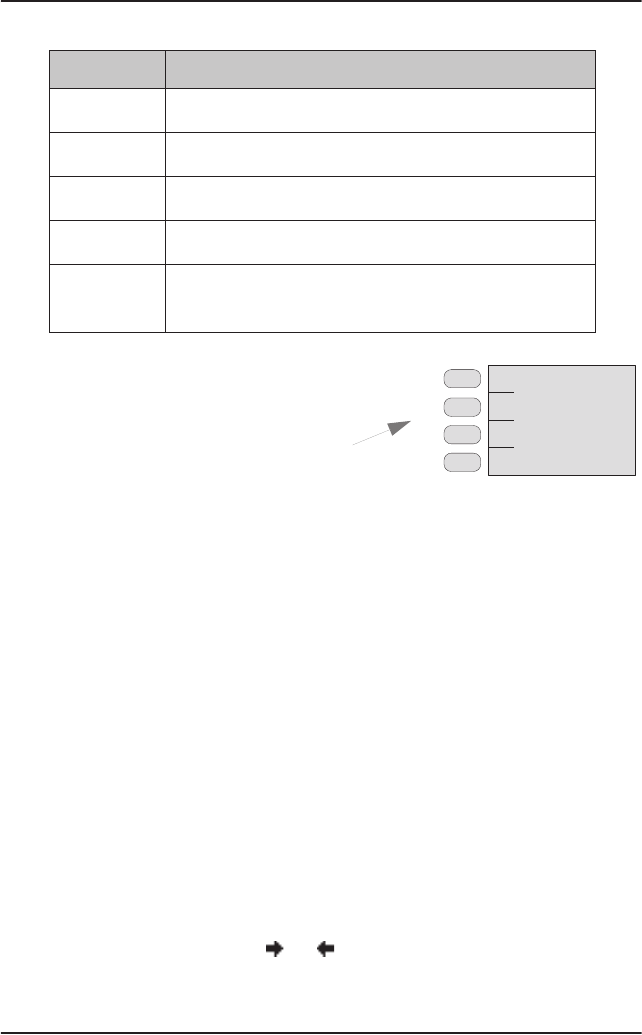
Chapter 2: Operation
10 General use and navigation
The functions of the SAILOR 6216
VHF DSC are accessed and set
using the four soft keys to the left
of the display. The current
function of a soft key is shown in
the display next to the soft key. For
some applications there are two control levels
•A top level showing the current information and options for this
application. This can be on one page, or on several pages.
•A setup screen showing the options you can configure for the specific
application.
Use the soft key MORE to display further applications.
Controller setup
In the CONTROLLER SETUP you set handset volume, external speakers and
display contrast. You can view the Software version and serial number.
To change a setting in the CONTROLLER SETUP, do as follows:
1. Press the soft key SETUP. If it is not in the display, press the soft key MORE
until SETUP appears.
2. Press the arrow soft key or to advance to CONTROLLER SETUP.
SCAN Scanning function
HAIL Loudhailer
FOG Fog horn
PBOOK Phone book
SETUP Setup pages for RADIO, HAILER/FOG, SYSTEM,
CONTROLLER and DSC
Soft key Function
4 soft keys
16
HI/LO
WATCH
CALL
MORE...
GPS Position
DISTRESS/CALL
INT

Chapter 2: Operation
General use and navigation 11
2222
Operation
3. Turn the selector wheel knob to go to a setting, then press
the selector wheel knob to change the setting.
4. Press EXIT to return to normal radio operation.
Parameter Description
Handset 1 vol: Adjust earpiece volume for handset 1: OFF, 1 to 14
Note: Default setting is OFF. If a handset is connected
to the front connector this value must be configured
to a value (1-14).
Handset 2 vol: Adjust earpiece volume for handset 2: OFF, 1 to 14
Note: Default setting is OFF. If a handset is connected
to the rear connector this value must be configured
to a value (1-14).
Ext. speaker FIX: Fixed level is set for external speaker
REL: Relative level following volume adjustment of
the internal speaker
Ext. fix/rel vol: External speaker fix or rel volume:
rel: -5 to 5. Offset relative to internal speaker steps
fix: OFF, 1 to 14
Language English
Contrast Display contrast, 1 to 5
Version Software version, read only
Serial Serial number of the radio, read only.
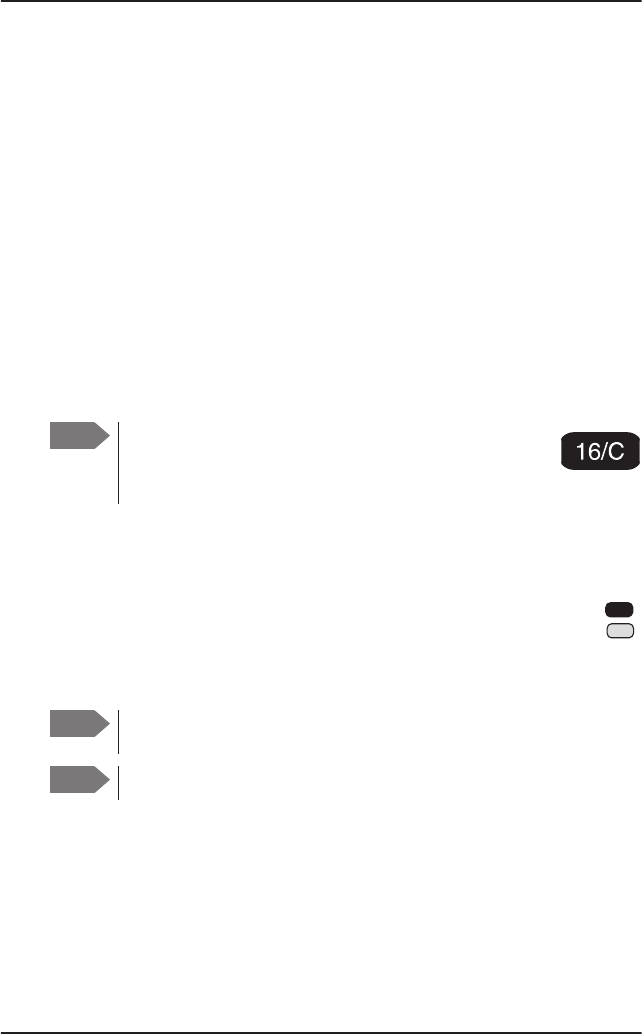
Chapter 2: Operation
12 VHF radio communication
VHF radio communication
In this section of the manual you find information on
•Basic VHF operation
•VHF channels
•Programming a call channel
•Naming a channel
Basic VHF operation
You can make VHF calls using the Handmicrophone or another speaking
device.
Quick guide to radio telephone calls
1. Press the PTT button on the speaking device. When the TX
indicator lights up in the display, the transmission is active.
2. To enable reception of a radio signal release the PTT button.
Note
A single, short press on the 16/C key will always bring
you to channel 16, the international calling and distress
channel, no matter which display the radio showed.
Note
Press PTT only when you are talking. Always say “Over.” just before
releasing the PTT button.
Note
One transmission is limited to 5 minutes duration.
TX
RX
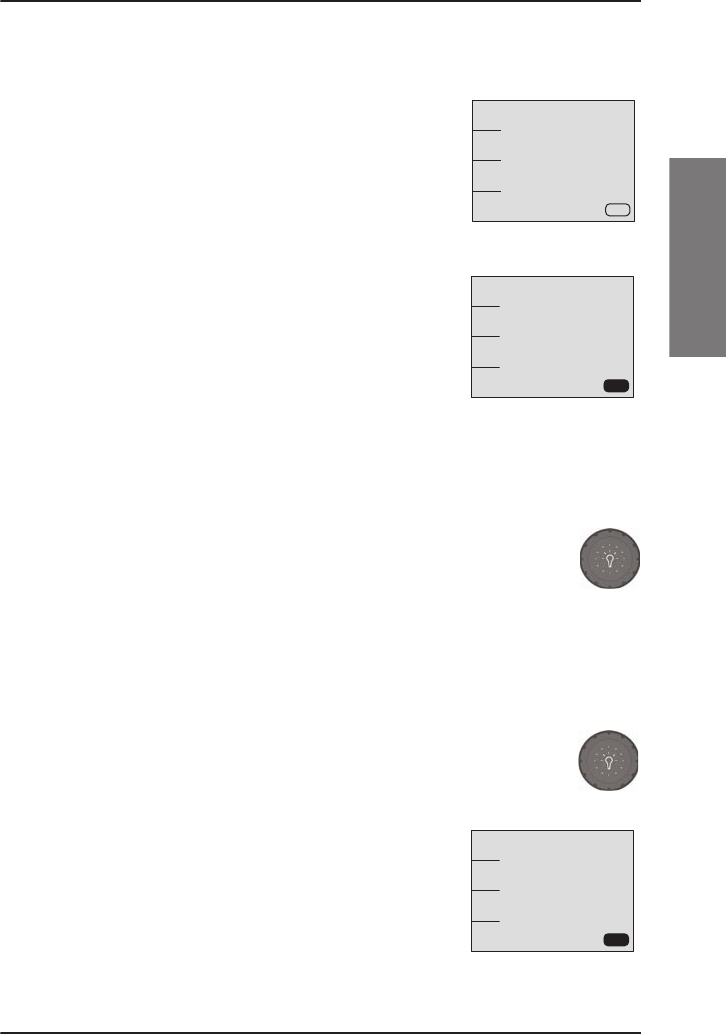
Chapter 2: Operation
VHF radio communication 13
2222
Operation
Receiving a radio telephone call on channel 16
When you hear your call name in the loudspeaker,
proceed as follows:
1. An RX symbol shows that the radio is receiving on
the working channel displayed.
2. Lift the Handmicrophone or take the handset.
3. Press the PTT key. A TX symbol shows that the
radio is transmitting on the working channel
displayed.
4. Repeat the name of the station calling you and
say: “This is [your ship’s name]”.
5. Suggest a working channel other than 16 by
saying: “Channel [suggested channel number]”.
6. Say: “Over.” and release the PTT key to allow the caller to confirm the
suggested new channel.
7. Switch to the new channel by turning the selector wheel knob to
the agreed channel and begin your conversation. Press PTT only
when you are talking.
Making a radio telephone call on channel 16
To make a radio telephone call, proceed as follows:
1. Select channel 16 by pressing the soft key 16/C or by turning the
selector wheel knob.
2. Lift the handset or take the Handmicrophone.
3. Press the PTT key. A TX symbol shows that the
VHF radio is transmitting on the working channel
displayed.
4. Say the name of the station you are calling three
times.
16
HI/LO
SCAN
CALL
MORE...
USGPS Position
DISTRESS/CALL
RX
16
HI/LO
SCAN
CALL
MORE...
USGPS Position
DISTRESS/CALL
TX
16
HI/LO
SCAN
CALL
MORE...
USGPS Position
DISTRESS/CALL
TX
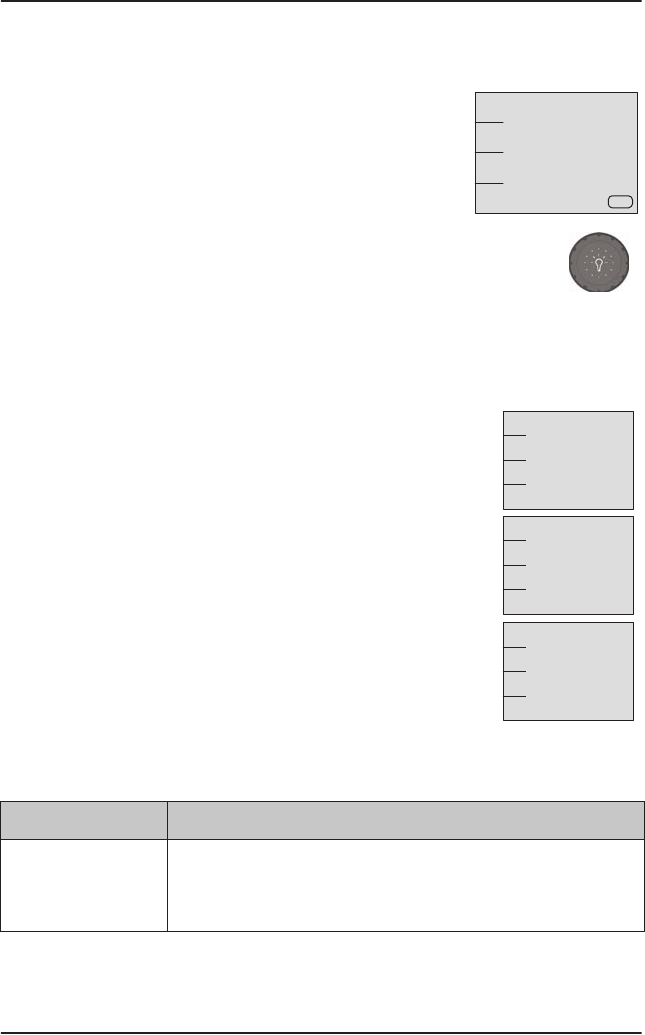
Chapter 2: Operation
14 VHF radio communication
5. Say: “This is [your ship’s name]”.
6. Say: “Over.” and release the PTT key to listen. An
RX symbol shows that the radio is receiving on the
working channel displayed
7. When answered, agree upon a working channel
other than 16.
8. Switch to the new channel by turning the selector
wheel knob to the agreed channel and begin your
conversation.
VHF channels
You can change channels whenever the channel
designator is displayed. Turn the selector wheel knob to
browse through all channels that are available in the
selected channel mode. The channels appear in the
display in the following order:
• Primary channels
• Weather channels (if any)
• Private channels (if any)
To quickly toggle between these 3 channel groups make
a long press and release the selector wheel knob. The
VHF radio toggles between the last selected channels in
the respective groups, i.e. the last selected weather
channel, the last selected private channel or the last selected primary channel.
If there are no channels defined in a group, it is not selected.
16
HI/LO
SCAN
CALL
MORE...
USGPS Position
DISTRESS/CALL
RX
6
HI/LO
SCAN
CALL
MORE... INTERSHIP
INT
GPS Position
W2
HI/LO
SCAN
CALL
MORE...
US
GPS Position
P2
HI/LO
SCAN
CALL
MORE...
INTGPS Position
VHF channel table Description
Primary channels
(no prefix)
For details see Maritime channels on page 75.
For instructions how to change a channel table see Radio
setup on page 22.
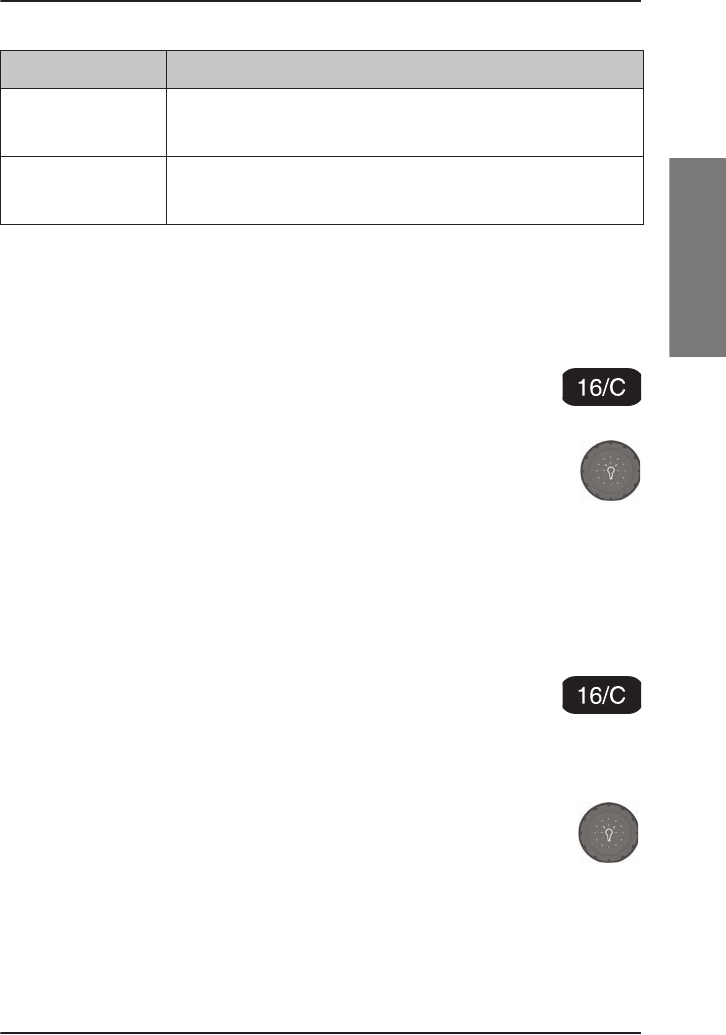
Chapter 2: Operation
VHF radio communication 15
2222
Operation
Programming a call channel
To program a call channel (or quick selection), do as follows:
1. Make an extra-long press (2.5 s duration) on the 16/C key.
2. Press the soft key CALL CH. The channel designator is flashing.
3. Turn the selector wheel knob to select the desired channel.
4. Press the soft key OK to confirm the new call channel and leave
edit mode.
Naming a channel
To name a channel, do as follows:
1. Make an extra long press on the 16/C key until NAME is shown
in the display next to one of the soft keys.
2. Turn the selector wheel knob to select the channel you want to name.
3. Press the soft key NAME.
4. Turn and press the selector wheel knob to enter the name, letter
by letter. Press BACK to move one character to the left. Press
CLEAR to the delete the current character and the following
characters. A long press on CLEAR deletes all characters.
Weather (WX) Weather channels have the prefix W. (For US and CA
channels only.)
Private (PRIV) Up to 40 user-defined private channels. Contact your dealer
for programming private channels.
VHF channel table Description

Chapter 2: Operation
16 VHF radio communication
5. Press the soft key OK to confirm the entered value
and to leave edit mode.
6. Press EXIT to return to return to the standard VHF
display.
Display for non-VHF applications
When the radio is used for functions other than VHF, the display is arranged
differently. The large channel display moves to the bottom line along with
selected icons.
The channel displayed in this line will always reflect the communication
channel on which the radio is tuned into for communication.
If PTT is pressed the radio transmits on the displayed channel (not valid for
hailer mode).
If a signal is received the signal is received on the displayed channel.
14
OK
BACK
CLEAR
CANCEL
INT
NEW_
PROGRAM

Chapter 2: Operation
VHF radio communication 17
2222
Operation
Engagement status
The radio is considered engaged when an active DSC-initiated communication
is ongoing, or communication is active on non-DSC initiated VHF operation:
• A new channel selected
• PTT pressed or,
• Voice signal received
The engagement state is used to prohibit incoming DSC calls from taking over
control of the transmitter channel, disrupting ongoing communication.
When the radio is engaged in VHF communication not initiated by DSC, this is
indicated with the icon in the lower right position of the display.
Engagement will automatically time-out on inactivity (in the absence of any of
the listed events above), and after an inactivity time specified in DSC setup,
Comm Inactivity on page 39.
To terminate the engagement immediately press the soft key .
Before the automatic disengagement, the icon will flash. To prolong the
engagement press the soft key .

Chapter 2: Operation
18 HI/LO transmission power
HI/LO transmission power
Press the soft key HI/LO to toggle the transmit power between low (1 W) and
high (25 W). If LO is not displayed, the transmit power is HI.
US channels: Local mode, 10 dB attenuation
To attenuate to the incoming signal, do as follows:
1. Press the soft key LOCAL to add 10 dB attenuation. If it is not in the display,
press the soft key MORE until LOCAL appears in the display.
US channels: Overriding LOW power for channels 13 and 67
When running in US mode you can override low power on the alternative call
channels 13 and 67. Do as follows:
1. With the VHF radio set to 13 and 67, press PTT on the speaking device.
2. Press the soft key OVRIDE to transmit with full power.
When you release the PTT button, the transmission power goes back to
low.
Note
Local mode is automatically exited when using channel 16. If you
want to use attenuation on channel 16 or a call channel, you must
set it manually each time.

Chapter 2: Operation
Watch 19
2222
Operation
Watch
The SAILOR 6216 VHF DSC radio
can be set to dual watch or triple
watch. In dual watch, the
working channel and channel 16
are watched. In triple watch the
working channel, channel 16
and the programmed call
channel are watched.
You can select the working
channel in any watch mode by
turning the selector wheel knob.
The working channel that is displayed is the channel used for dual or triple
watch. If there is a signal in one of the watched channels and squelch opens,
the display shows the channel in which the signal is received.
Using WATCH
1. To start watch press the soft key WATCH. The radio
enters the last watch mode. It is displayed in the
action line.
2. To stop WATCH press WATCH again, or press PTT
on the speaking device.
For instructions how to change between DUAL and
TRIPLE WATCH see Radio setup on page 22.
Note
If PTT is operated during any watch mode. the WATCH function is
terminated and you transmit on the displayed channel. Watch mode
may be resumed after releasing the PTT button if the scan resume
time is set up in SETUP, for instructions see Radio setup on page 22.
16
9
16
924
Dual watch Triple watch
Working channel
+ channel 16 Working channel
+ channel 16
+ call channel
6
HI/LO
[9]+[16]
TRIWATCH
WATCH
INT
MORE...
SCAN
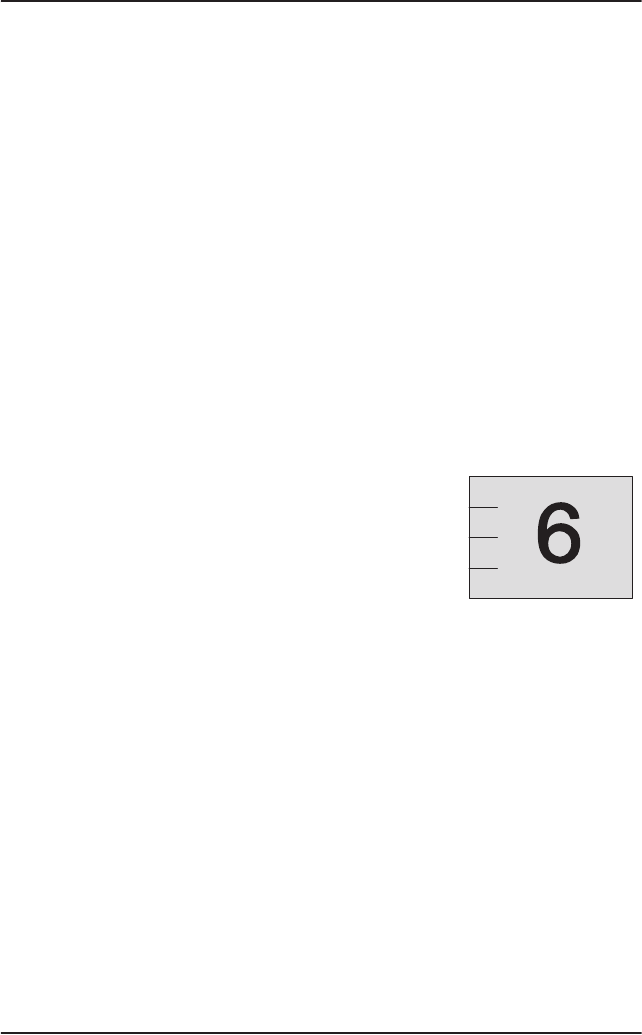
Chapter 2: Operation
20 Scan
Scan
The radio has a scanning function for tagged channels. Any available channel,
including weather and private channels, can be tagged and added to the
scanning sequence. As default the radio scans with priority scanning of
channel 16. If a signal is received while in any scanning mode, only channel 16
continues to be watched.
If there is a signal in one of the scanned channels, the display shows the
channel in which the signal is received. Pressing PTT while a signal is received
stops scanning and the radio is tuned into the displayed channel.
Using SCAN
1. To start scanning press the soft key SCAN. The SCAN menu is shown. Press
START to start scanning.
2. To stop SCAN press SC STOP, or press PTT on the
speaking device.
3. To tag a channel to include in the scanning
sequence turn the selector wheel knob until the
wanted channel is in the display. Then press the
soft key TAG. The display shows the channel
number and the word TAG at the right side of the display.
4. To remove a channel from the scanning sequence, turn the selector wheel
knob until the tagged channel is displayed. Then press the soft key TAG to
remove the tag.
When scanning is activated the working channel is displayed in a different
format (open). This indicates the radio is not tuned into the displayed channel.
The displayed working channel is temporarily included in the scanning list
(although no TAG icon is shown).
If PTT is pressed while scanning, the scanning is stopped and transmission
starts immediately on the displayed working channel.
EXIT
TAG
[TAG]+[16]
PRIORITY SCAN
TAG
STOPSC
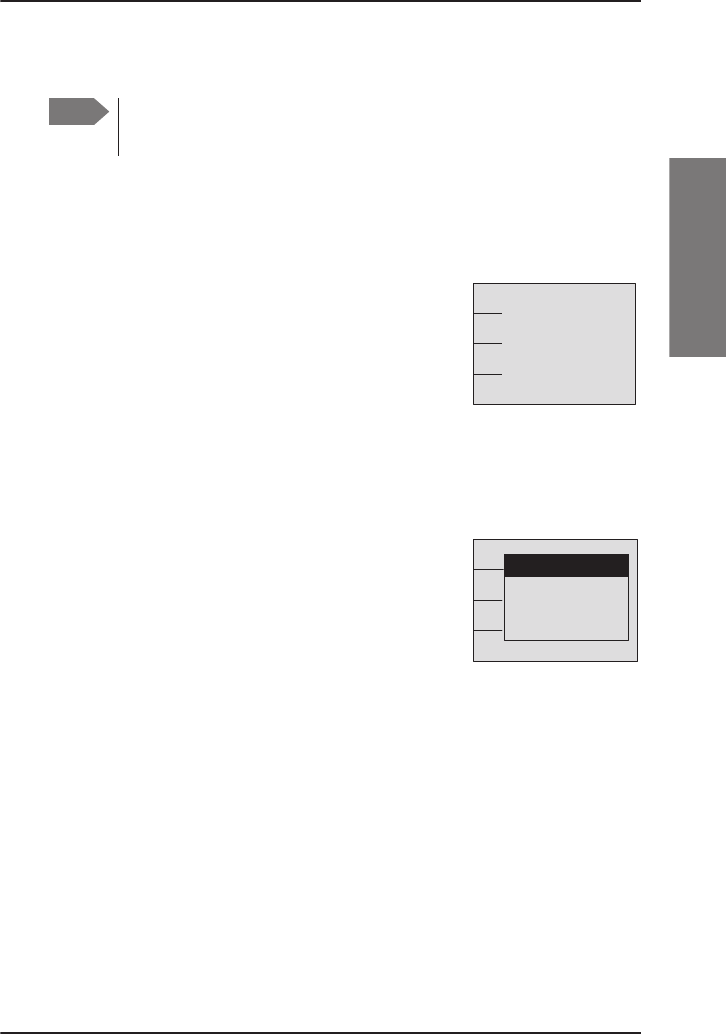
Chapter 2: Operation
Scan 21
2222
Operation
US channels: Watch alarms for NOAA Weather alerts
You can turn on or off an independent watch alarm for a specific weather
channel.
To turn on or off an independent NOAA weather alarm do as follows:
1. In the SCAN menu, turn the selector wheel knob to
select a specific weather channel.
2. Press the soft key WX to tag this weather channel
for NOAA weather alert.
3. On the display you can see that the selected
weather channel alert watch is enabled. In this example it is [W2].
The weather channel set-up for the alarm is scanned frequently during
scanning, watch or when the radio is not operated or receiving on a
working channel.
4. If a NOAA weather alert is detected on a weather
channel, beep tones are presented and a pop-up
window is displayed. Press YES to switch to the
weather channel.
Note
NOAA weather channels are available in the waters of USA and
Canada only.
W2
EXIT
[TAG]+[16]
PRIORITY SCAN
SC STOP [W2]
WX
TAG
YES WEATHER ALERT
NOAA WEATHER
ALERT. SWITCH TO
WEATHER
CHANNEL?
NO
WEATHER ALERT

Chapter 2: Operation
22 Radio setup
Radio setup
In the RADIO SETUP you set scan and watch mode, select the channel table
and can set and view the ATIS code. To change a setting in the RADIO SETUP,
do as follows:
1. Press the soft key SETUP. If it is not in the display, press the soft key MORE
until SETUP appears.
2. Press the arrow soft key or to advance to RADIO SETUP.
3. Turn the selector wheel knob to go to a setting, then press
the selector wheel knob to change the setting.
4. Press EXIT to return to normal radio operation.
Para-
meter Description
Scan
Hang
Time
Scan hang time, in seconds on an active receiving working channel.
The time is measured from the signal is detected. The radio remains
on the channel for the set time interval, if a signal was detected.
OFF: Resumes scanning when signal disappears (default)
4, 6, 8, 10: Hang time in seconds.
Scan/
watch
Resume
Scan resume time, in seconds. When the programmed time of
inactivity has elapsed, and when watch/scan has been aborted using
a press on PTT, or after power-up, scan or watch is resumed.
OFF: Automatic resume is deactivated (default)
3, 6, 10, 15, 20, 25, 30: Resume time in seconds.
Watch
Mode
DUAL: Dual watch monitoring the working channel and the priority
channel (channel 16, default for international channels).
TRIPLE: Triple watch. The working channel is watched with the
priority channel (channel 16) and the programmed call channel (if
any, otherwise dual watch).
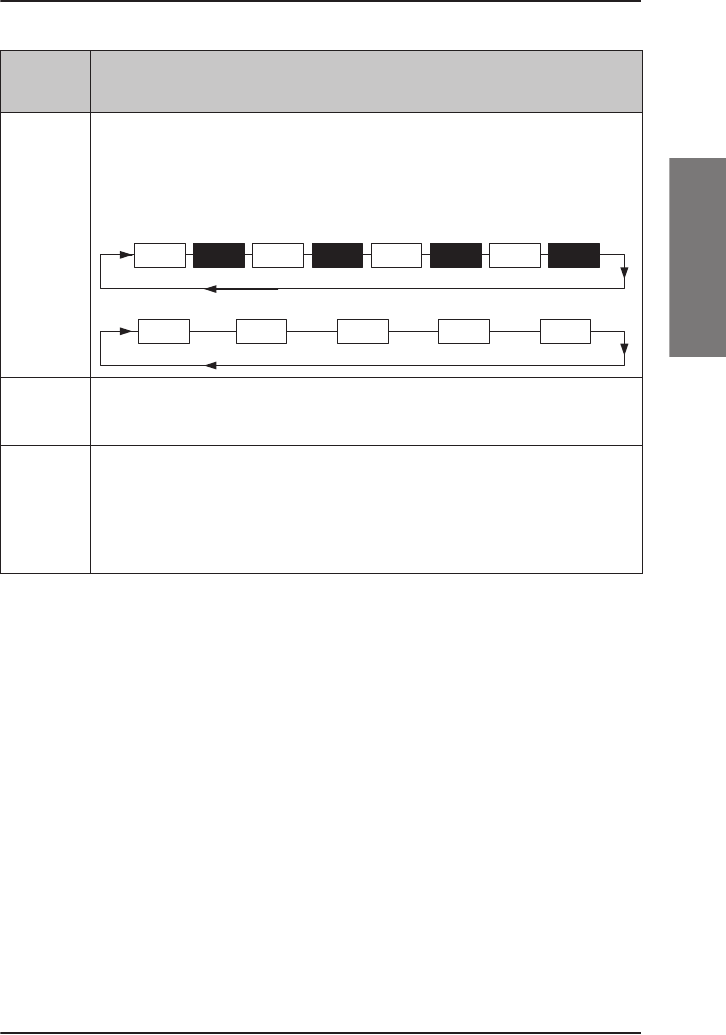
Chapter 2: Operation
Radio setup 23
2222
Operation
Priority
Scan
ON: All channels tagged for scanning are scanned while monitoring
channel 16. (default).
OFF: Only the channels tagged for scanning are scanned in sequence,
not channel 16, unless it is tagged for scanning.
Channel
Mode
To select the channel table for the primary channel. Channel tables
available: US, CAN, ALT, PRIV, See also VHF channel table on page 14.
Band-
width
Selection of the bandwidth for the fixed pre-programmed channels.
This is recommended from Radio Regulations:
Wide: Wide band is 25kHz channel bandwidth (default)
Narrow: Narrow band defines a channel bandwidth of 12.5kHz
Para-
meter Description
Priority scan: On
Channel
16 Channel
16 Channel
16
Channel
01 Channel
02 Channel
03
Channel
04 Channel
16
Priority scan: Off (normal scan)
Channel
01 Channel
02 Channel
03
Channel
04
Channel
05
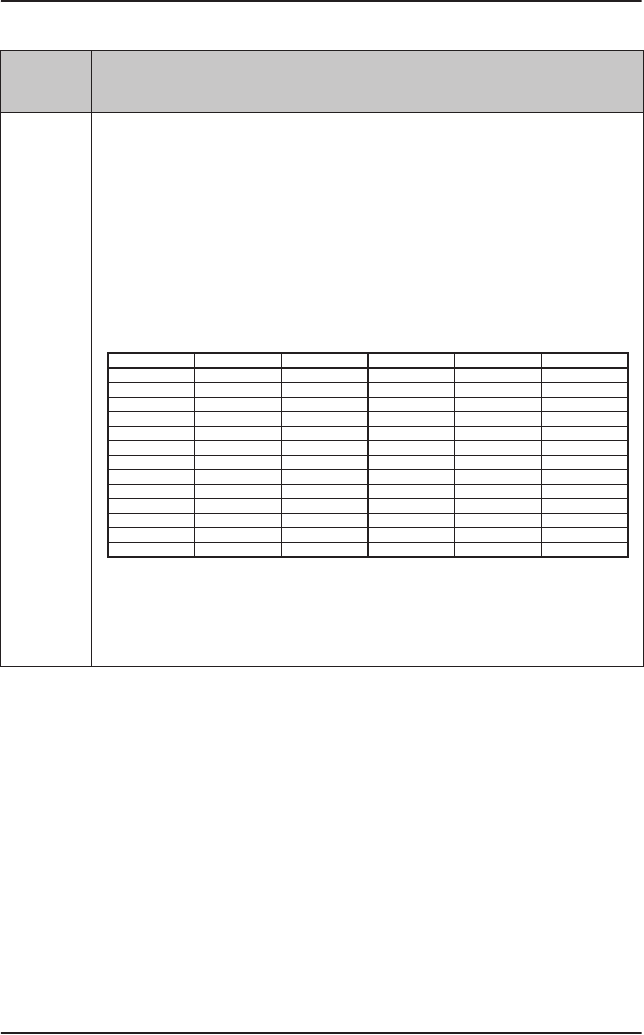
Chapter 2: Operation
24 Radio setup
ATIS
code
The ATIS code (Automatic Transmitter Identification System) is used
for identification to marine coast and inland stations and its use is
mandatory in a number of European inland waterways such as e.g.
the river Rhine.
Like the MMSI number the ATIS number is issued by the relevant
authority.
Enter the format of the programmed ATIS code according to the
following call sign prefix conversion table:
Note: The ATIS number can be programmed by the operator once. If a
wrong number has been entered and stored, or if there is a
requirement to change it, contact your authorized dealer.
Para-
meter Description
Character Phonetic Value Character Phonetic Value
AAl
p
ha 1 N November 14
B Bravo 2 O Oskar 15
C Charlie 3 P Pa
p
a16
D Delta 4 Q Quebec 17
E Echo 5 R Romeo 18
F Foxtrot 6 S Sierra 19
G Golf 7 T Tan
g
o20
H Hotel 8 U Uniform 21
I India 9 V Victor 22
J Juliett 10 W Whiske
y
23
K Kilo 11 X X-ra
y
24
L Lima 12 Y Yankee 25
M Mike 13 Z Zulu 26
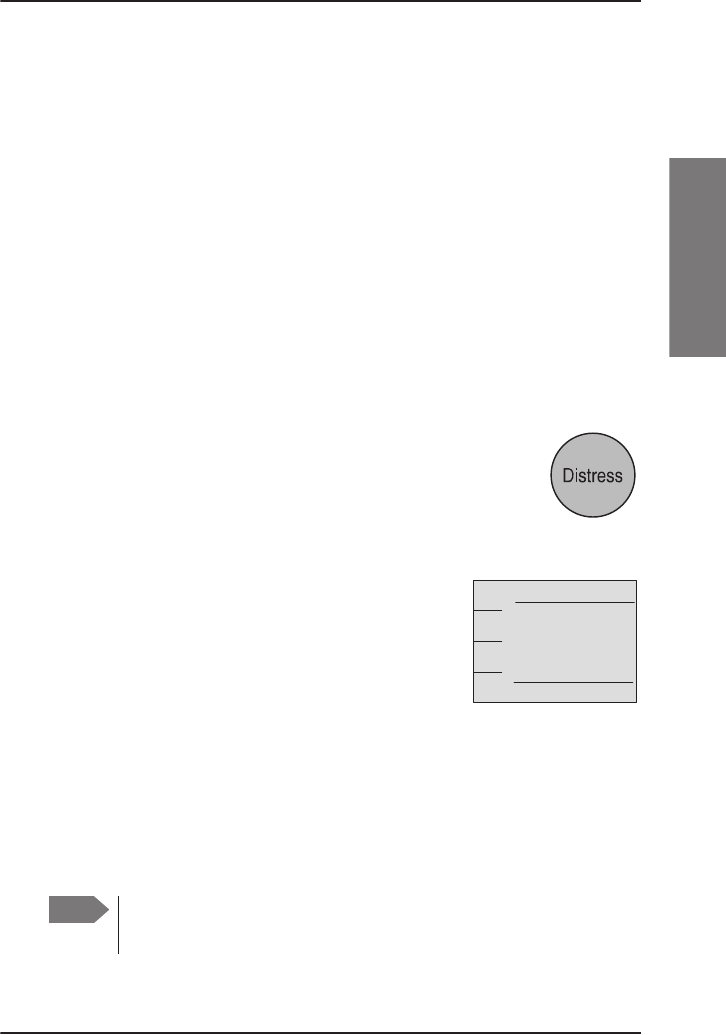
Chapter 2: Operation
DSC calls 25
2222
Operation
DSC calls
In this section of the manual you find information on:
•Sending, acknowledgment and cancel own distress
•Receiving distress calls
•DSC calls for communication
•DSC setup
Sending, acknowledgment and cancel own distress
Sending a distress message
To send a distress message do as follows:
1. Lift the cover over the red distress button and press and hold
the distress button for longer than 3 seconds. For short step-
by-step instructions how to proceed when sending a distress
message see Emergency calls on page iv.
When the distress signal is sent, CH70 and Tx
appear in the display. A 2-seconds beep tone is
heard.
2. The radio watches for a DSC acknowledgement
tansmission on channel 70.
3. To pause the automatic resend procedure press
the soft key PAUSE.
4. To annul the distress message press the soft key ANNUL. See also
Cancelling of own distress on page 27.
5. When a distress acknowledgement is received, start distress
communication on channel 16 to inform about your distress situation.
Note
If no distress acknowledgement is received within a period of 3,5 to 4
minutes, the distress message will automatically be retransmitted.
OWN DISTRESS
WAIT FOR ACK
ELAPSED TIME: 0:00:10
(ACTIVE)
REPEAT IN 2:11
CH: 16
PAUSE
ANNUL
INFO
MORE
(Example)
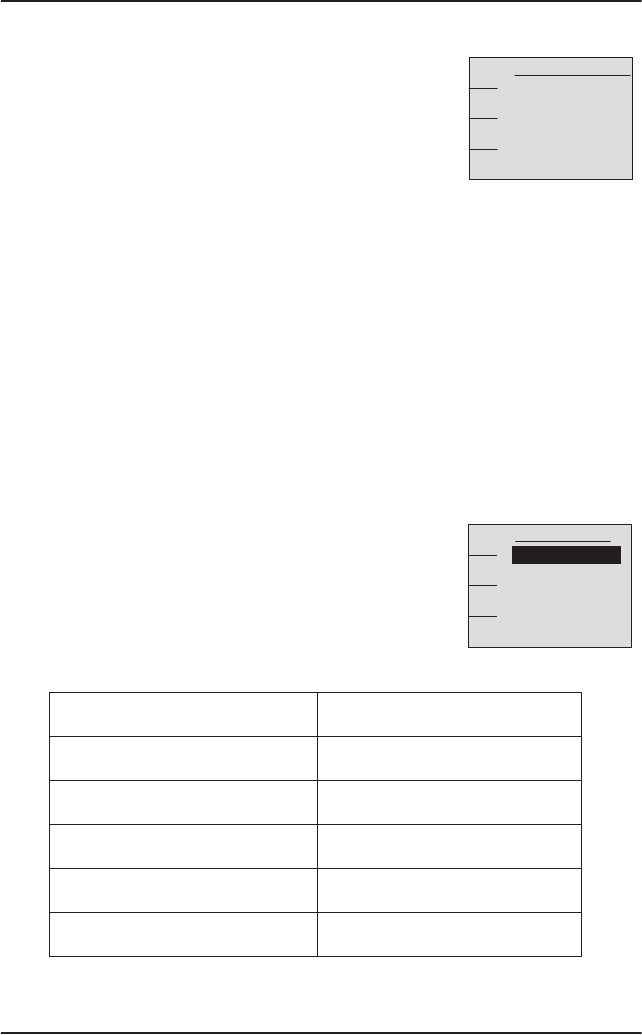
Chapter 2: Operation
26 DSC calls
Having pressed the red distress button and sent the
distress message, press the soft key INFO to display
further information:
• STATION: shows the radio’s MMSI number.
• NAT: shows the nature of distress, see also
Sending a distress message with specified nature
on page 26.
• LAT:, LON:, POS UTC: shows the distress position data as transmitted.
• MODE: shows the communication mode.
If you sent a distress message, the VHF radio is automatically set to channel
16, the channel reserved for international distress, safety and calling.
Sending a distress message with specified nature
When sending distress messages you can include the distress nature in the
message. To include the distress nature in the distress message do as follows:
1. From top-level standby press the soft key ALERT.
If it is not in the display, press the soft key MORE
until ALERT appears.
2. Press the selector wheel knob, then turn it to
select among the supported natures of distress:
DISTRESS (DETAIL)
PAUSE
ANNUL
MORE
INFO
STATION: 123456789
NAT: UNDESIGNATED
LAT: 23°23.3234 N
LON: 123°23.3234 W
POS UTC: 12:34
MODE: TELEPHONY
(Example)
FIRE, EXPLOSION DISABLED (and adrift)
FLOODING UNDESIGNATED
COLLISION ABANDONING (ship)
GROUNDING PIRACY (/armed robbery attack)
LISTING (in danger of capsizing) MAN OVERBOARD
SINKING
DISTRESS CALL
EXIT
LOG UNDESIGNATED
LAT: 23°23.3234 N
LON: 123°23.3234 W
POS UTC: 12:34
PUSH DISTRESS
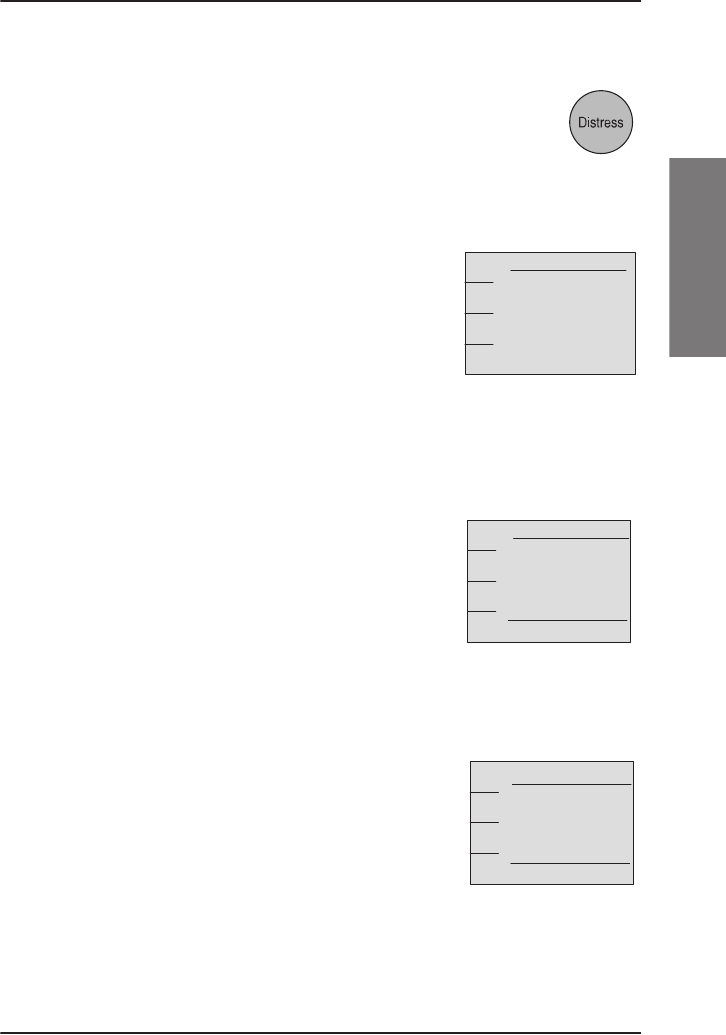
Chapter 2: Operation
DSC calls 27
2222
Operation
3. Press the selector wheel knob to accept the selected nature of distress.
4. Then lift the cover of the red distress button and push the
Distress button for 3 seconds.
Acknowledgement of own distress
When the SAILOR 6216 VHF DSC receives an
acknowledgement of distress from another vessel or
station, a 2-tone alarm sounds. The display shows
the MMSI number of the station who sent the
distress acknowledgement call, the status and the
time passed since the distress acknowledgement
arrived (format: mm:ss).
•Press SILENT to only switch off the 2-tone alarm. A press on any other key
also switches off the 2-tone alarm.
•Press the soft key INFO to display further data for this call.
•Press the soft key OK to view the status of this
distress call.
If the same Distress call comes in more than once,
the 2-tone alarm sounds briefly and terminates
automatically.
Cancelling of own distress
If you need to cancel a sent distress message do as
follows:
1. The display shows that a distress message has
been sent. Press the soft key ANNUL.
OWN DISTRESS
SILENT
MORE
INFO
DISTRESS ACKNOWL.
FROM: 002233445
TO: ALL SHIPS
DISTR MMSI: 123456789
NAT: UNDESIGNATED
LAT: 23°23.3234 N
OK
OWN DISTRESS
QUIT
INFO
MORE
ACKNOWLEDGED
MMSI: 002233445
ELAPSED TIME 0:12
(ACTIVE)
ACTIVE
CH: 16
OWN DISTRESS
WAIT FOR ACK
ELAPSED TIME: 0:00:10
(ACTIVE)
REPEAT IN 2:11
CH: 16
PAUSE
ANNUL
INFO
MORE
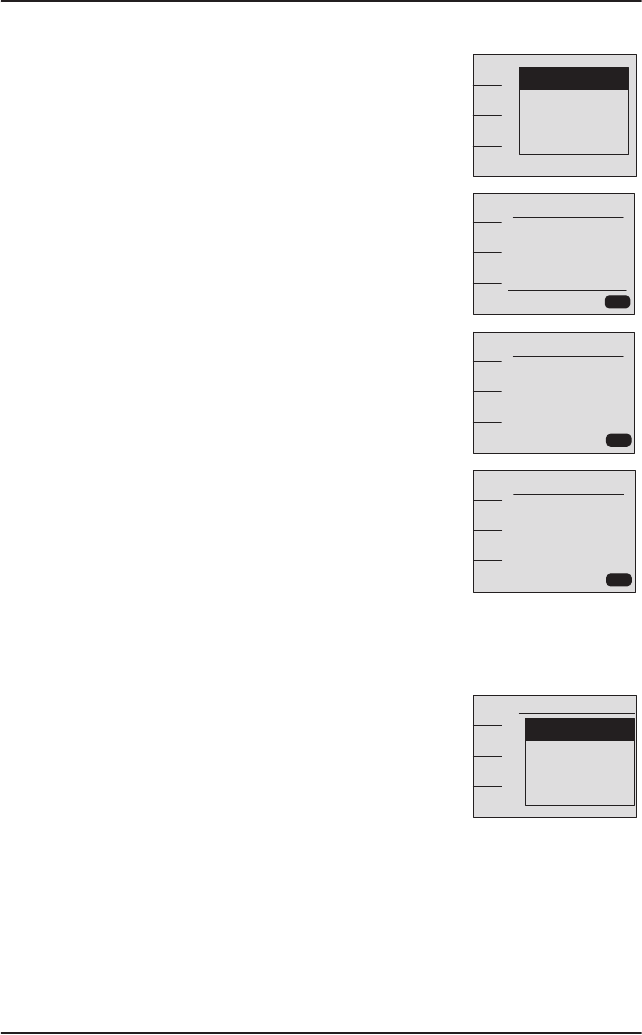
Chapter 2: Operation
28 DSC calls
2. Press the soft key YES to go ahead with the
cancelling process. At this stage you have the
option to press the soft key NO to return to distress
sending procedure.
3. The SAILOR 6216 VHF DSC will send the Self-
cancellation call on channel 70 and the display
automatically shows the message that you should
say when cancelling the distress with a radio
message.
4. Press the soft key INFO to scroll to the next display
to proceed with the voice cancel
5. Press the soft key OK to go to the acknowledged
state. Own distress is cancelled now.
Power failure while in distress
In case of a power failure or switch-off during the
transmission of a Distress the SAILOR 6216 VHF DSC
gives an audible warning after power-up and
automatically resumes sending Distress 10 seconds
after power up.
Within the 10 seconds you have the following options:
•Press QUIT to terminate the active distress procedure (acknowledged or
unacknowledged)
•Press CONFIRM (or do nothing) to resume the sending Distress procedure.
YES
NO DO YOU WANT TO
CANCEL YOUR
OWN DISTRESS?
WARNING
OWN DISTRESS
-- TRANSMITTING –
CANCEL DISTRESS
PREPARE FOR VOICE
CANCEL
CH: 70
OK
INFO
HI/LO
SETUP
TX
VOICE CANCEL
”All stations, All stations,
All stations This is [vessel
name 3 times].
Our MMSI number is
123456789 .”
OK
TX
VOICE CANCEL
Our position is latitude
23°23.3234 N, longitude
123 °23.3234 W
CANCEL our Distress
Alert of 12:34 hours”
OK
TX
MY DISTRESS
16
WAITING FOR REPLY
ELAPSED TIME 6:16
(ACTIVE)
REPEAT IN 2:11
RESUME
SENDING
DISTRESS IN
8 SECONDS
WARNING
QUIT
CONFIRM
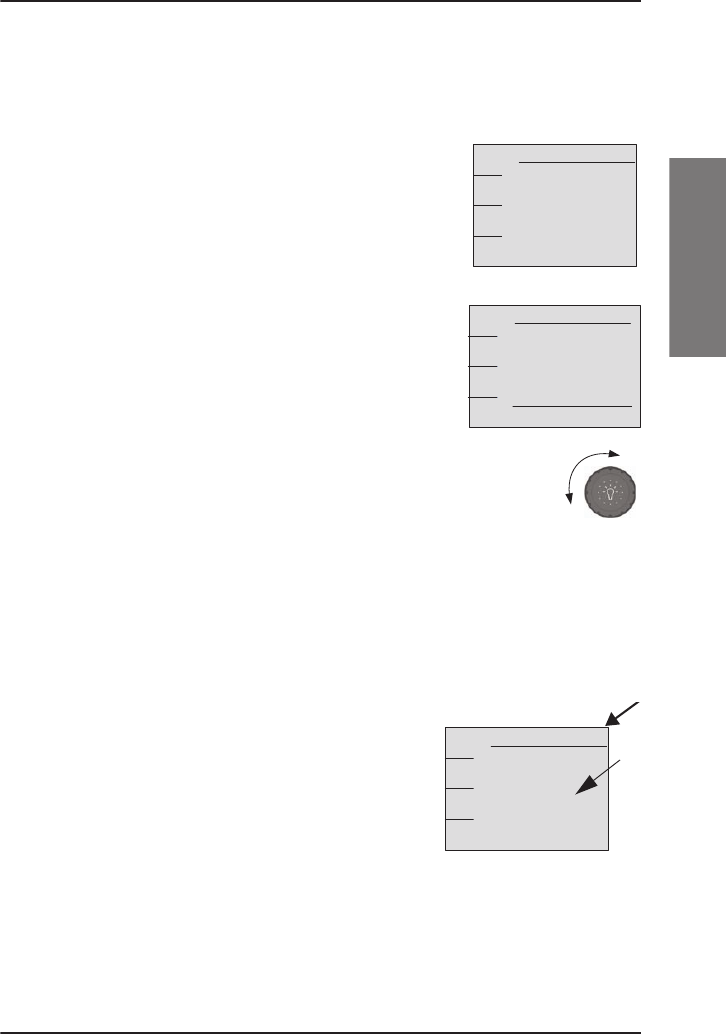
Chapter 2: Operation
DSC calls 29
2222
Operation
Receiving distress calls
When the radio receives a distress call, the 2-tone alarm sounds.
Types of distress calls are DISTRESS, DISTRESS ACK,
DISTRESS RELAY and DISTR. RELAY ACK.
1. To switch off the 2-tone alarm press the soft key
SILENT. A press on any other key also switches off
the 2-tone alarm.
2. If you decide to stay in the communication loop to
receive follow up information, updates etc., press
the soft key OK.
3. If you don’t accept the distress call, press the soft
key CANCEL, then the radio logs the call.
4. Monitor channel 16 as a coast station may require
your assistance. If the radio is not in channel 16, turn the
selector wheel knob or use the key 16/C to go to channel 16.
5. The radio receives the first distress acknowledgement call and
the 2-tone alarm sounds again. To switch off the 2-tone alarm press the
soft key SILENT. A press on any other key also switches off the 2-tone
alarm.any key.
Distress call with errors
If a distress call contains errors, it is still received
and errors in the data are shown as underscores
(_).
CALL RECEIVED
SILENT
MORE
CANCEL DISTRESS CALL
FROM: 219005678
TO: ALL SHIPS
STATION: 219005678
NAT: UNDESIGNATED
LAT: 23°23.3234 N
OK
DISTRESS ALERT
NOT ACKNOWLEDGED
ELAPSED TIME 0:12
MMSI: 219005678
(ACTIVE)
QUIT
VIEW
MORE
HOLD
CH: 16
CALL RECEIVED
SILENT
CANCEL DISTRESS CALL
LON: 123°23.__34W
POS UTC: 12:34
MODE: TELEPHONY
(ERR)
OK
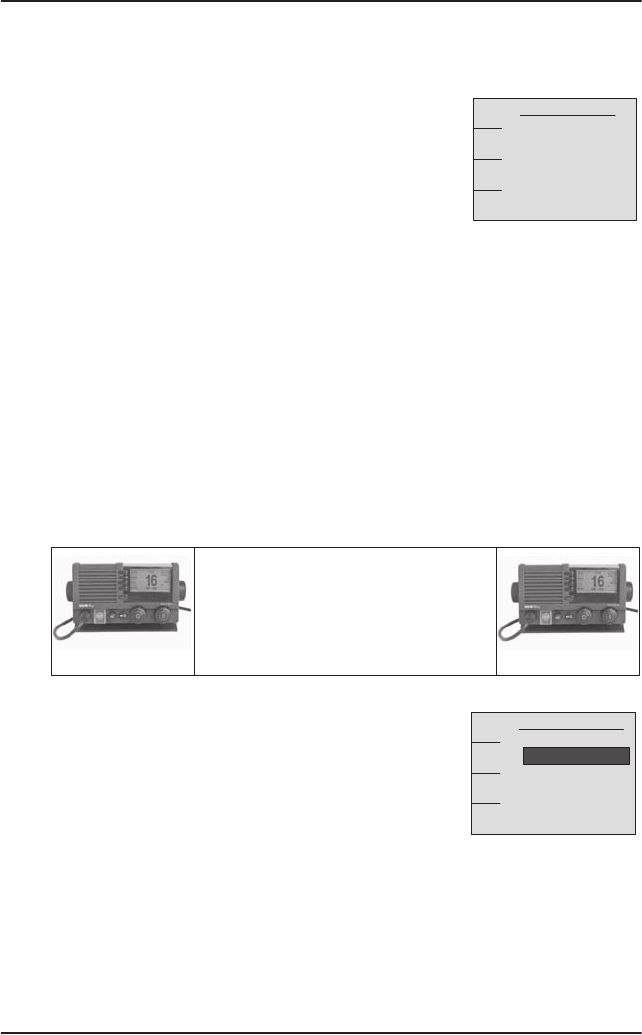
Chapter 2: Operation
30 DSC calls
Distress call log
As long as you are part of a distress session, i.e. you
have not pressed QUIT, you receive distress messages
and can track all distress messages for the current
distress event.
Do as follows:
1. Press the soft key LOG. If it is not in the display, press the soft key MORE
until LOG appears.
2. Press the soft key NEXT and PREV to browse the received Distress
messages.
3. Press the soft key EXIT to leave the log.
DSC calls for communication
With a DSC call you can establish a radio communication with one or several
specific radios on a suggested VHF channel.
To make a DSC call for communication, do as follows:
1. Press the soft key CALL.
The default call is an individual routine call. Enter
the 9-digit MMSI number of the vessel you want
to contact or use the phone book to select a
frequently called contact.
Received Distress 1/3
EXIT
NEXT
PREV
2009 -8-12 10:11
DISTRESS CALL
FROM: 219005678
TO: ALL SHIPS
STATION: 219005678
NAT: UNDESIGNATED
Radio A Radio B
1. DSC call message from Radio A to Radio B
2. DSC acknowledge from Radio B to Radio A
3. Radio A + B go on the agreed VHF channel
4. Press PPT and start talking
Type: INDIVIDUAL
EXIT
PHONEB
SEND
Channel : 72
MORE
DSC CALL
To: 123000000
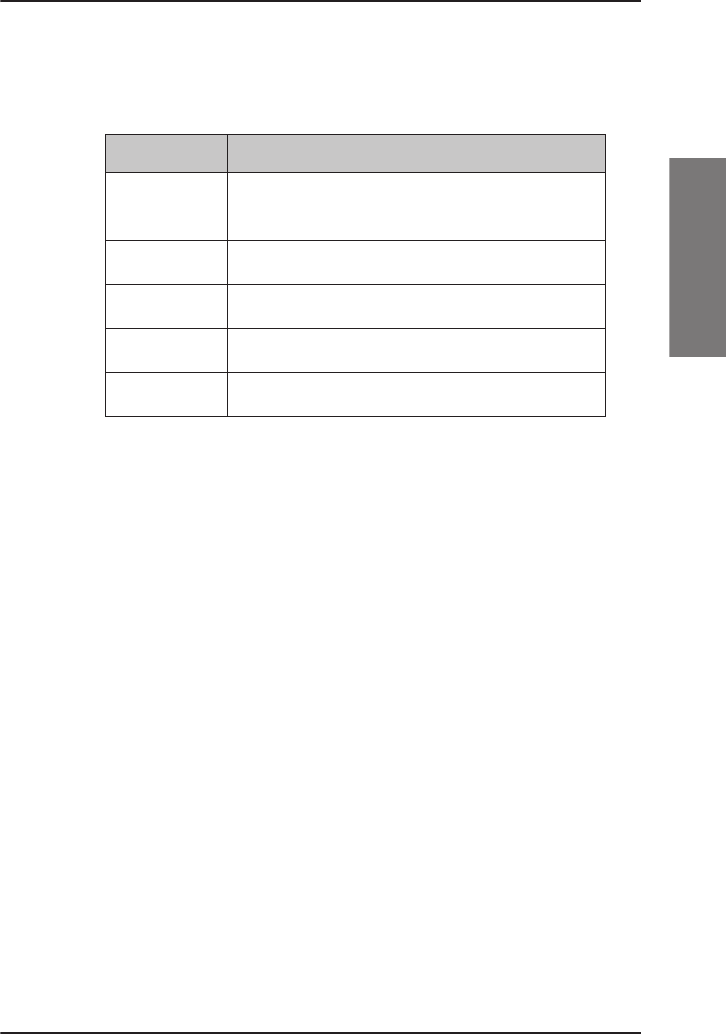
Chapter 2: Operation
DSC calls 31
2222
Operation
2. Press and turn the selector wheel knob to select other call types or set the
details for the call:
•Type:
• Press and turn the selector wheel knob to change the suggested VHF
channel for following communication.
3. Press the soft key SEND to make the call.
Sessions
A DSC session (or automated procedure) is defined as a collection of DSC calls
(transmitted and/or received) that are related to the same event (e.g. a
distress event) or established call (e.g. an individual call request followed by
an acknowledgement).
A session can be either active or on hold. The active session has control over
the radio transmitter.
A session can have a purpose. For example if the purpose is to establish a
communication on a working channel.
The non-DSC VHF communication is considered as a session that can be
active (engaged) or on hold (dis-engaged). See also Engagement status on
page 17.
DSC call type Category
Individual Routine (default) or safety calls, calls to a ship
or a station
Group calls Routine
All ship calls Safety (default) or urgency
Safety test Test call, check of safety equipment
Position Routine position request
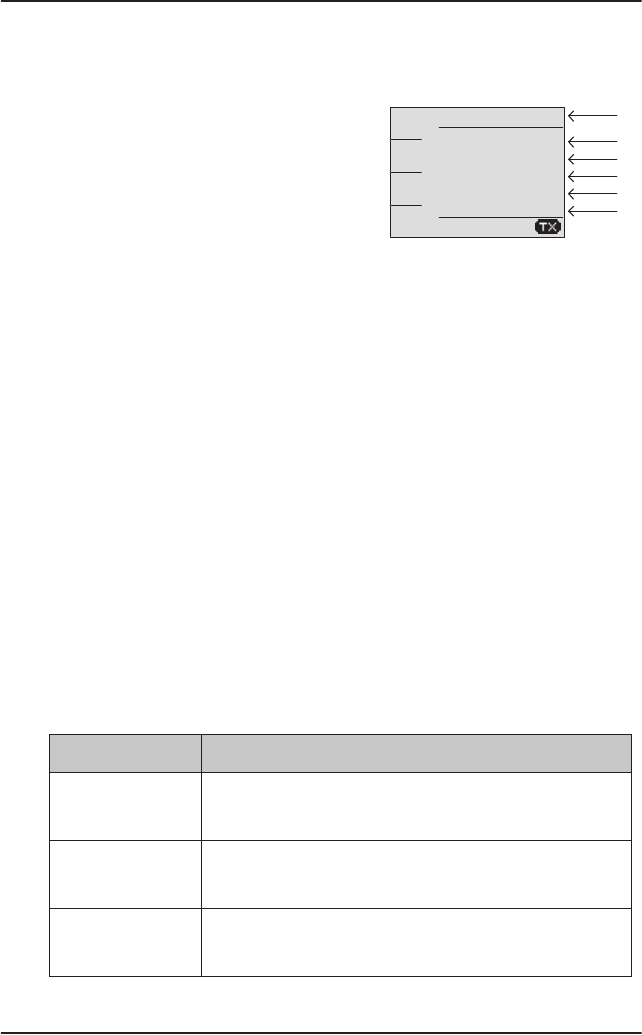
Chapter 2: Operation
32 DSC calls
Display for a DSC session
1. Head line showing the type of call that
initiated the DSC session, see table
below for a list of available head lines.
2. Session status line displays the current
state of the session:
•WAIT FOR ACKNOWLEDGE – You
made an individual call to a station and are awaiting a reply to
establish connection.
• OCCUPIED - The DSC transmission mechanism waits until the DSC
channel (70) is free.
• TRANSMITTING - Transmission of a DSC message is ongoing.
• IN COMMUNICATION WITH – The communication has been established.
3. The MMSI number of the other party, if contact to a specific station or
group shall be established.
4. Elapsed time since the reception of a call request or an acknowledgement.
5. Session state:
• (ACTIVE) — transmitter tuned into the communication channel.
•(HOLD) — parked session.
6. Channel used for following communication (if any) when the session is
active.
Headline Explanation
OWN DISTRESS The ship is in own distress. See also Sending a
distress message on page 25.
DISTRESS RX You watch or participate in a distress communication
for another station in distress
RELAY calls
(numerous)
You watch or participate in a distress communication
for another station in distress
INDIVIDUAL TX
WAIT FOR ACKNOWLEDGE
MMSI: 278888913
ELAPSED TIME
0:12
(
ACTIVE
)
CHANNEL
:15
LO CH:15
QUIT
INFO
MORE
HOLD
1
2
3
4
5
6

Chapter 2: Operation
DSC calls 33
2222
Operation
Soft keys to control DSC sessions
Call/session types vary in control options, and options may also change if a
session changes its state. The following table gives an overview of the DSC soft
key commands available:
ALL SHIPS TX/RX You have sent / received an all ships call
GROUP TX/RX You have sent / received a group call
INDIVIDUAL
TX/RX
You have either sent a call request to a station to
establish contact, or another station has made a call
to you to establish contact. The call needs a reply.
TEST TX/RX You either have sent a SAFETY TEST call or have
received a SAFETY TEST call from another station that
needs to be replied.
POSITION TX/RX A position request was either sent or received.
Headline Explanation
Soft key Radio function
QUIT Terminates the DSC session
HOLD Puts the DSC session hold if it is active (return to other
non-DSC functions)
ACTIVE Activates the DSC session
INFO Shows details about the DSC call
RESEND Transmits an identical call if available
NEWCH Replies with a new channel if an individual call is
received with a communication channel specified
which is not available in the radio, or the operator
decides to change the channel.

Chapter 2: Operation
34 DSC calls
See also Handling a background session on page 37.
UNABLE Constructs a reply to the caller if an individual call is
received which is not compatible with the radio modes.
SILENT Silences alarms. Any key silences the alarm but this
soft key function will do only this.
ACK Acknowledges a received call request with the
suggested parameters.
POS (Own
Distress)
A shortcut to own position data information.
PAUSE (Own
Distress)
Pauses the automatic repetition of distress
transmissions
RESUME (Own
Distress)
Resumes automatic repetition of distress
transmissions (if paused)
ANNUL
(Cancel Own
Distress)
Cancels an inadvertently transmitted distress
CONFIRM
(Cancel Own
Distress)
Confirms action and proceed sequence, used in cancel
distress procedure
INFO (in
Cancel Own
Distress)
Turns page of text message.
LOG (Received
distress)
A filtered version of the log displaying received calls
relevant to the current distress event.
Soft key Radio function
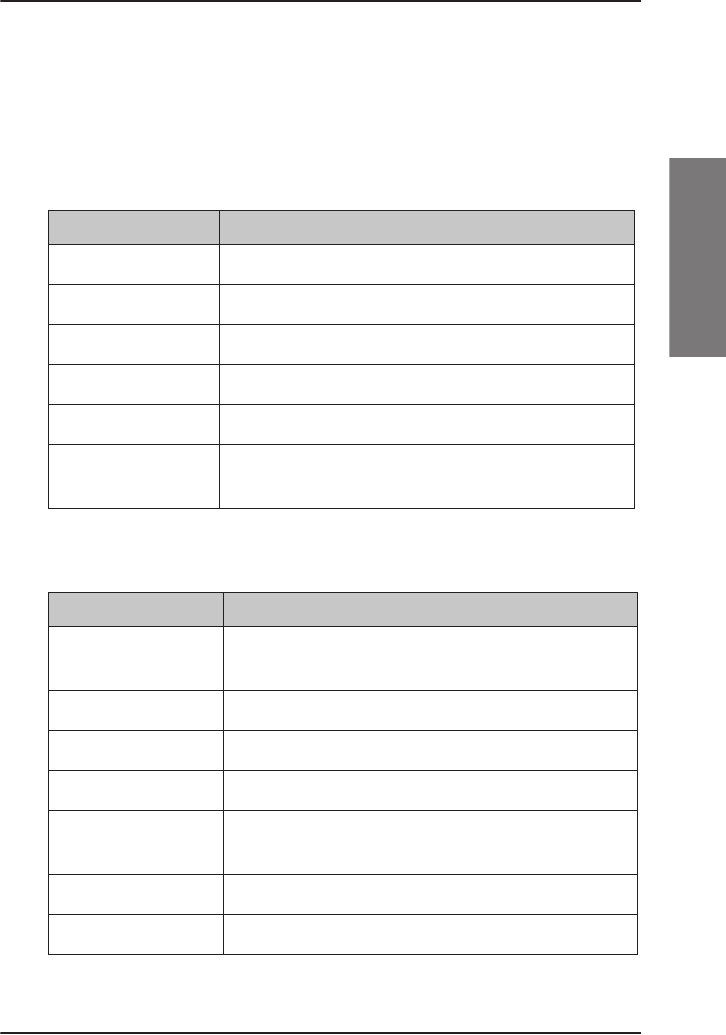
Chapter 2: Operation
DSC calls 35
2222
Operation
Detail information for DSC sessions (soft key: INFO)
A DSC session is updated based on DSC calls received or transmitted. Press the
soft key INFO to show the details for the current session.
For distress events a sequence of calls may contribute to the complete view
and status of the session. Detailed fields for distress are:
For other session types the soft key function INFO typically shows the details
from a single call. Detail fields for other calls than distress are:
Details — Distress Explanation
DISTR-MMSI The vessel in distress
NAT Nature of Distress
LAT Latitude position of station in distress
LON Longitude position of station in distress
POS UTC Time of position
MODE Communication mode (Simplex/Semi-duplex
Telephony supported)
Details —other calls Explanation
CALL Type (on received call) – The call type may be shown on
call reception
CAT Category of the call: Urgency, Safety or Routine
FROM The initiator of the call
TO The intended receiver of the call (unless All Ships)
MODE Communication mode (Simplex/Semi-duplex
Telephony supported)
CHANNEL Subsequent communication channel
LAT Latitude position returned upon a position request
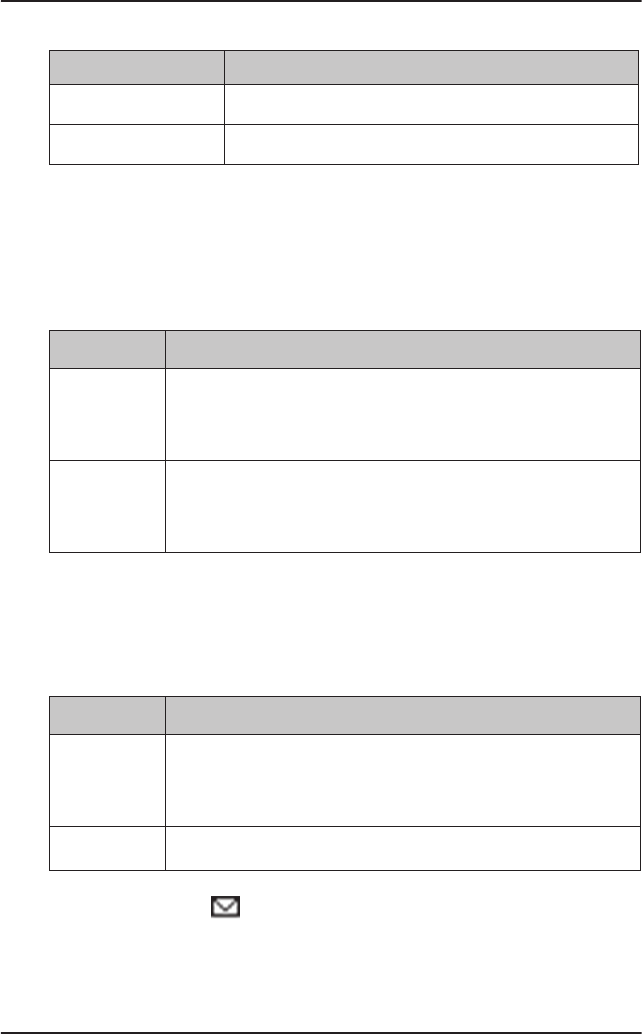
Chapter 2: Operation
36 DSC calls
Receiving DSC calls
If the radio is IDLE (not engaged in another session) and a DSC call is received
the call details are shown on the display. The following options (soft keys) are
available:
If the radio is engaged while receiving a DSC call, the call is shown if it was of
higher priority (importance for safety or life). Otherwise it is just queued in the
DSC call log for later handling (marked as unread).
If the call is displayed the following soft keys appear:
An envelope symbol is shown whenever there are unread messages in
the DSC log. Unread messages are automatically retrieved from the log as
LON Longitude position of station in distress
POS UTC Time of position
Details —other calls Explanation
Soft key Radio function
ACK
(individual)
The call is acknowledged immediately and the radio is
afterwards tuned to the communication channel (if any
suggested)
OK (group
or all ships)
The radio is already tuned to the suggested communication
channel (if any suggested). Pressing this button will display
the DSC session view.
Soft key Radio function
ACCEPT If you accept the new incoming call the radio terminates the
ongoing session and the session view is initiated for the
new call.
LOG The call is logged in the DSC call log as an unread message.
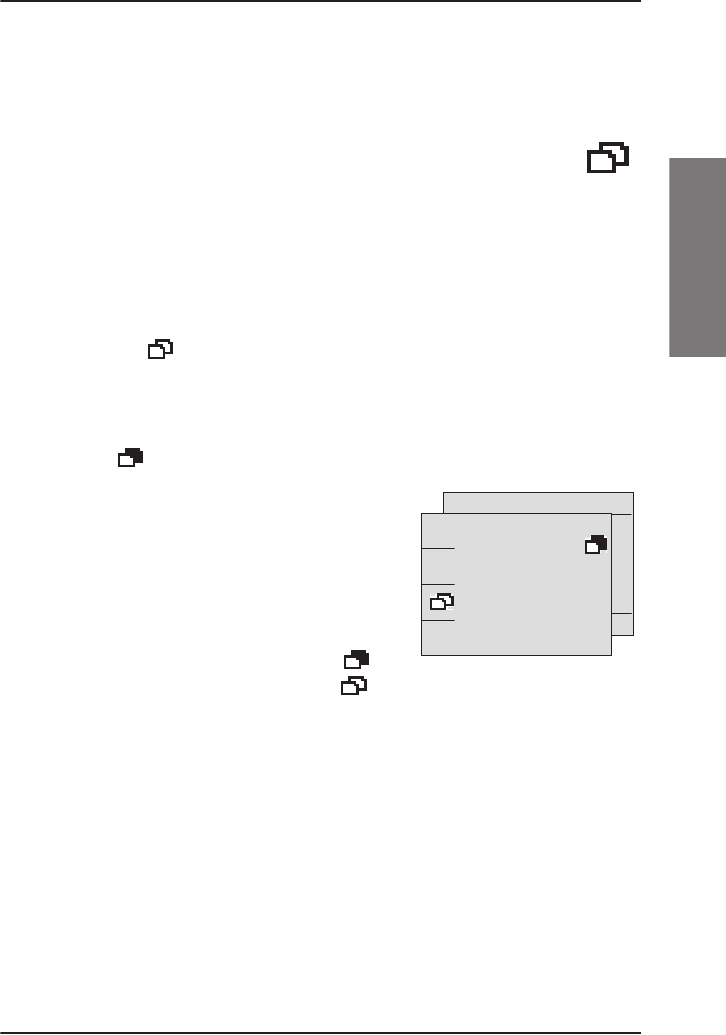
Chapter 2: Operation
DSC calls 37
2222
Operation
soon the current DSC session is terminated. The call with the highest priority
(importance for safety or life) is shown first.
Handling a background session
The equipment is designed with the possibility to control a DSC session
simultaneously with a VHF communication session. The sessions can keep
track of their session state and the communication channel used.
If a DSC session is put on HOLD it is automatically put in the background (VHF
communication display appears on the previous communication channel).
The soft key is used to toggle between the VHF communication and a DSC
session on hold.
The DSC session on hold can receive calls that are pertinent to the session,
even when the session is not displayed. If the background receives updates
the icon is shown.
Example: An individual call request has been
sent. While waiting for the
acknowledgement of the call,
communication is engaged on VHF
(press the soft key HOLD on the DSC
session view). The
acknowledgement is received from
the called station (the icon is
shown). Press the soft key and ACTIVE to engage in the DSC
initiated communication.
INDIVIDUAL TX
QUIT
INFO
MORE
HOLD
6
HI/LO
WATCH
MORE... INTERSHIP
INT
GPS Position
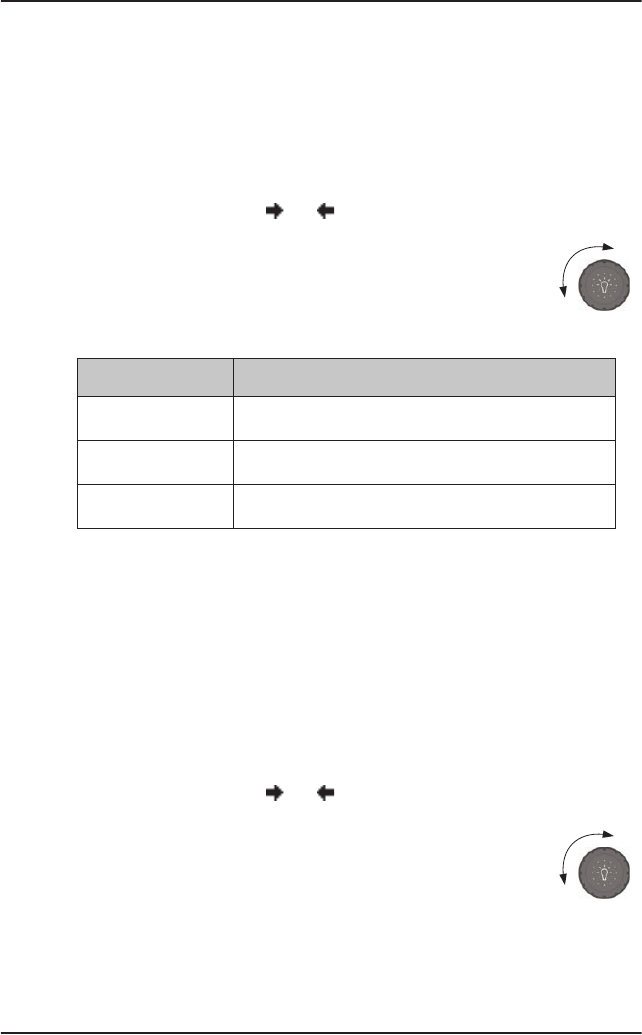
Chapter 2: Operation
38 DSC calls
DSC call logs
To display a DSC call log in the DSC CALL LOGS, do as follows:
1. Press the soft key SETUP. If it is not in the display, press the soft key MORE
until SETUP appears.
2. Press the arrow soft key or to advance to DSC CALL LOGS.
3. Turn the selector wheel knob to go to a setting, then press
the selector wheel knob to change the setting.
4. Press EXIT to return to normal radio operation.
Use the soft keys NEXT and PREV to leaf through all logs.
DSC setup
To change a setting in the DSC SETUP, do as follows:
1. Press the soft key SETUP. If it is not in the display, press the soft key MORE
until SETUP appears.
2. Press the arrow soft key or to advance to DSC SETUP.
3. Turn the selector wheel knob to go to a setting, then press
the selector wheel knob to change the setting.
DSC call log Description
Received Distress Shows a log of up to 20 received distress calls.
Transmitted Calls Shows a log of up to 20 transmitted calls.
Received Calls Shows a log of all received non distress calls.

Chapter 2: Operation
DSC calls 39
2222
Operation
4. Press EXIT to return to normal radio operation.
DSC setting Description
Position Info Available position information.
Here you can enter position data, see also Position
and MMSI Information on page 8.
Auto-Ack Test Auto-acknowledgement of test DSC messages
OFF - Disabled
ON – Enabled (default)
Auto-Ack Individual Auto acknowledgement of individually addressed,
non distress DSC messages
OFF - Disabled (default)
ON – Enabled
Non-Distr. Inactivity Inactivity time-out to exit non-distress functions
(e.g. in setup) without automatic time-out (OFF):
Range: OFF, 1 to 30 minutes, in 1 min. steps
Default: 15 min.
Distress Inactivity Inactivity time-out for received distress DSC
automated procedures without automatic time-
out:
Range: OFF, 1 to 30 minutes, in 1 min. steps
Default: OFF
Comm Inactivity Inactivity time-out of non DSC communication
(VHF).
Range: 10 to 600 seconds, in 10 s steps
Default: 30 s
Non-Distr.Alarms Non-distress DSC alarms
OFF: Disabled
ON: Enabled (default)

Chapter 2: Operation
40 DSC calls
Auto-switch
Channel
Enable automatic channel switching on reception
of DSC calls with subsequent communication
channel information, while the radio is not
engaged (for calls other than individual station
calls of category distress or urgency).
ON (default)
OFF - LCK icon indicates that the channel is locked
and must be selected manually
DSC Self Test You can set the radio to run a DSC self test.
OFF: Disabled (default)
RUN: Run test.
For further details about this test see DSC routine
testing on page 68.
DSC setting Description

Chapter 2: Operation
Phone book 41
2222
Operation
Phone book
Use the phone book when making a DSC call. You can enter up to 50 contacts.
A contact has the following details:
• Name (up to 20 characters)
•Type (SHIP, GROUP or COAST STATION)
•MMSI number
• Channel
• Position Auto Acknowledge (yes or no) or Listen to Group
The phone book is always sorted alphabetically by contact names. Use the soft
key FILTER to toggle between CONTACTS - ALL, COAST, SHIP or GROUP. After
having selected a contact, the phone book closes automatically.
Using the phone book to make a DSC call
To call a contact using the phone book do as follows:
1. Press the soft key CALL. If it is not in the display, press the soft key MORE
until CALL appears. The DSC call composer is shown in the display.
2. Press the soft key PBOOK.
3. Turn the selector wheel knob to scroll to the phone book entry that you
want to call.
4. Press the selector wheel knob to select the contact.
5. Press the soft key SEND to make the call.

Chapter 2: Operation
42 Phone book
Adding a contact to the phone book
To add a contact to the phone book do as follows:
1. Press the soft key PBOOK. If it is not in the display, press the soft key MORE
until PBOOK appears in the display.
2. Press the soft key ADD.
3. Press the selector wheel knob to enter the <Name> field.
Enter the name by turning the selector wheel knob to the desired letter,
press the selector wheel knob to accept the letter and advance to the next
letter. To finish press the soft key OK.
4. Press and turn the selector wheel know to select the Type: SHIP, GROUP or
COAST STATION.
5. MMSI: Turn and press the selector wheel knob to enter the contact’s MMSI
number (9 digits), press the soft key OK to accept.
6. CHAN (optional): Press and turn the selector wheel knob to select the
preferred channel for this contact, press the soft key OK.
7. Position Auto Ack (for Type SHIP or COAST STATION): Press and turn the
selector wheel knob to select YES or NO for this contact, press the soft key
OK. This will allow auto-ack of position requests for this contact.
or:
Listen to Group (for Type GROUP): Press and turn the selector wheel knob
to select YES or NO for this contact, press the soft key OK. The radio will
respond to calls to the specified group.
8. Press the soft key SAVE to save the contact information.
9. Press EXIT to leave the phone book and return to VHF operation.

Chapter 2: Operation
Phone book 43
2222
Operation
Editing a contact
1. Press the soft key PBOOK. If it is not in the display, press the soft key MORE
until PBOOK appears.
2. Press the soft key EDIT.
3. Press and turn the selector wheel knob to browse through the details of the
contact.
4. Continue as described in Adding a contact to the phone book from step 2
onwards.
Deleting a contact
1. Press the soft key PBOOK. If it is not in the display, press the soft key MORE
until PBOOK appears.
2. Turn the selector wheel knob to browse to the contact you want to delete.
3. Press the soft key MORE until DELETE appears.
4. Press the soft key DELETE.
5. Press EXIT to leave the phone book and return to VHF operation.
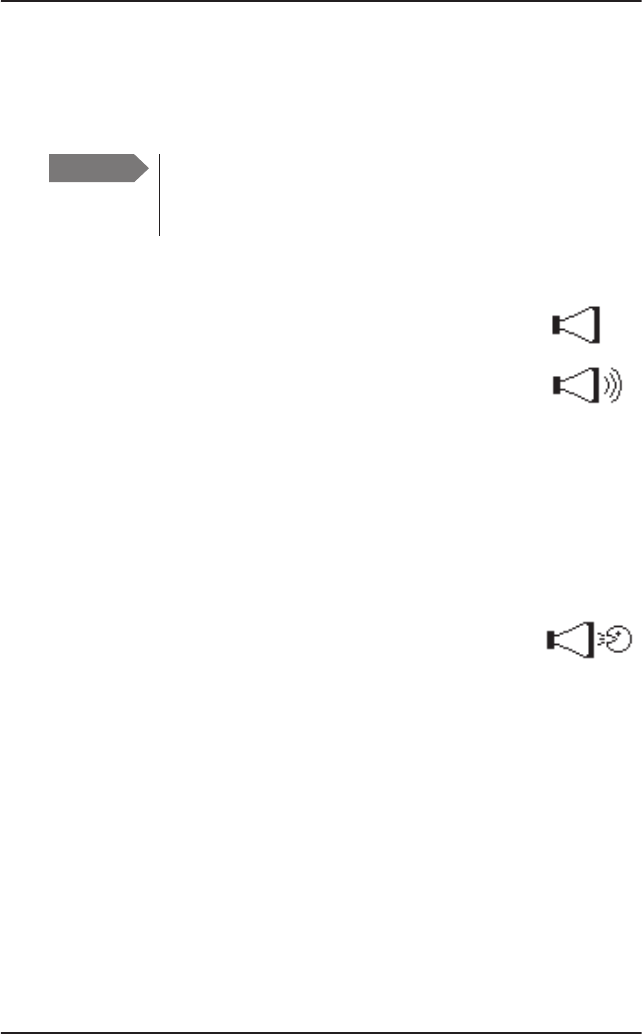
Chapter 2: Operation
44 Loudhailer with talk-back
Loudhailer with talk-back
The SAILOR 6216 VHF DSC supports a loudhailer with a talk-back function.
To activate the loudhailer do as follows:
1. Press the soft key HAIL. If it is not in the display, press the
soft key MORE until HAIL appears.
2. Press PTT on the speaking device to activate the HAILER.
3. To change the receiving radio channel, turn the selector
wheel knob.
4. To adjust the HAIL volume press the PTT button and turn the volume knob.
5. Press the soft key EXIT to leave the hailer function.
Using the hailer with talk-back
While in hailer mode the hailer can also be used as a
microphone. For details how to set the talk-back mode see
Hailer and Fog horn setup on page 47. Once set up talk-back is
activated when you are in hailer mode and the PTT button is released.
When talk-back is active your crew can talk to you via the loudhailer horn unit
into the loudspeakers. The talk-back volume can be independently adjusted
on the volume knob while talk-back is active (TB Volume). If a signal is
received on the radio while in talk-back mode, the received radio signal will
be heard in the speakers. The received radio signal will be reproduced with
the normal volume level.
Important
When the hailer is in talk-back mode and a radio signal is
received, the radio signal has a higher priority and is heard in
the loudspeaker.
62
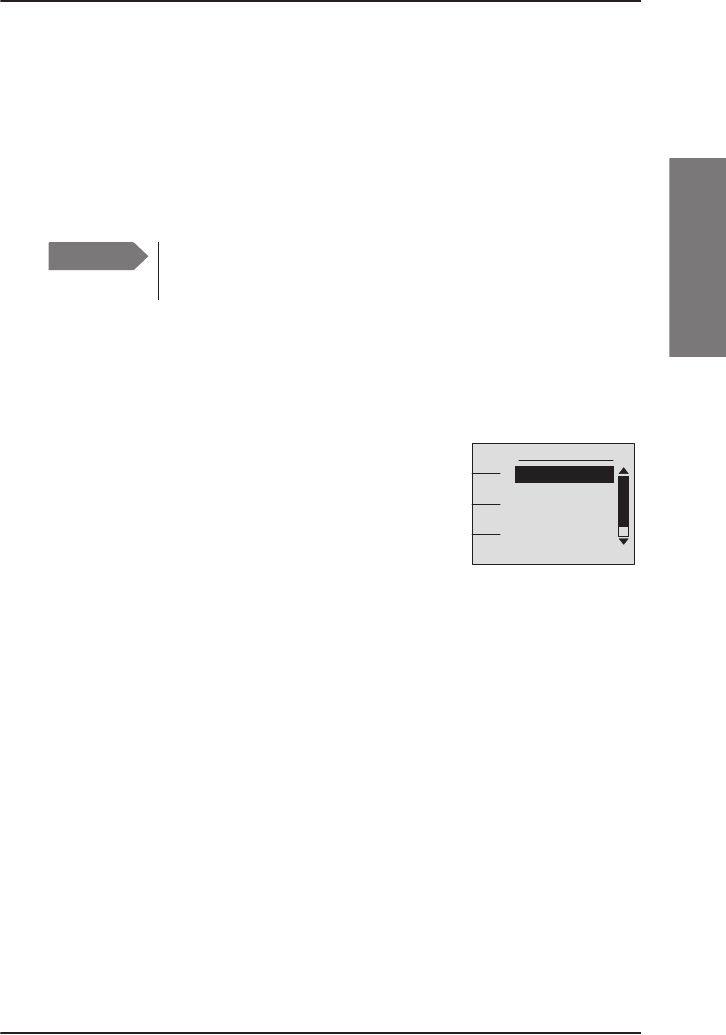
Chapter 2: Operation
Automatic foghorn 45
2222
Operation
Automatic foghorn
The SAILOR 6216 VHF DSC has an automatic fog horn application with several
foghorn patterns. Once started, it runs in the background while running any
other application. The fog horn may be combined with the loudhailer talk-
back mode. When the fog horn is activated, the text FOG is shown in the top
right corner of the display.
The "TB" symbol is shown in the display if Foghorn talk-back is selected and
the automatic foghorn is activated.
The foghorn patterns are fixed and sent out as whistle blasts or as a bell
pattern. The tone frequency can be set in the foghorn setup menu.
To activate the foghorn do as follows:
1. Press the soft key FOG. If it is not in the display,
press the soft key MORE until FOG appears.
Important
Loudhailer talk-back may be active between foghorn
emissions. See Hailer and Fog horn setup on page 47.
FOG
OFF
EXIT
UNDERWAY
STOP
SAIL
HORN
SETUP
TOW
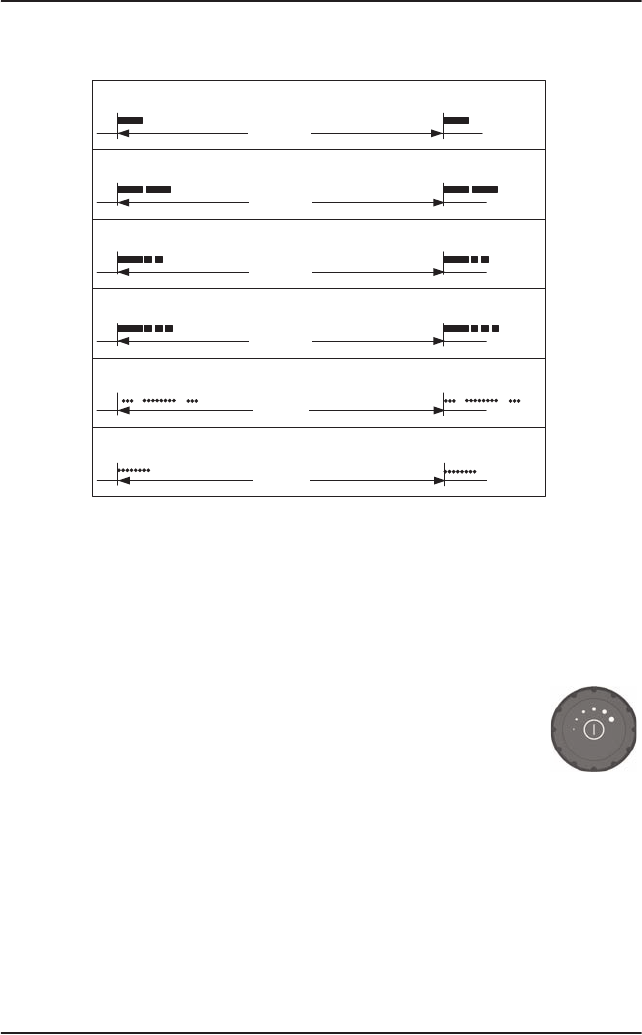
Chapter 2: Operation
46 Automatic foghorn
2. Use the selector wheel knob to browse through the patterns available.
3. Press the selector wheel knob at the wanted pattern to accept the pattern.
4. To deactivate the foghorn, turn the selector wheel knob to browse to OFF
and press the selector wheel knob.
Foghorn test tone
To manually control that the foghorn produces a blast tone, do
as follows:
The HORN key appears when no active fog pattern is
emitted (OFF). Press and hold the soft key HORN to activate
the blast tone and adjust the volume of the foghorn by
turning the volume wheel knob.
every 120 s
every 120 s
UNDERWAY
1 long blast
STOP
2 long blasts
every 120 s
every 120 s
SAIL
1 long blast followed by 2 short blasts
TOW
1 long blast followed by 3 short blasts
AGROUND
3 rings, followed by 5 s constant bell pattern, then 3 rings
ANCHOR
One 5 s bell pattern
every 60 s
every 60 s
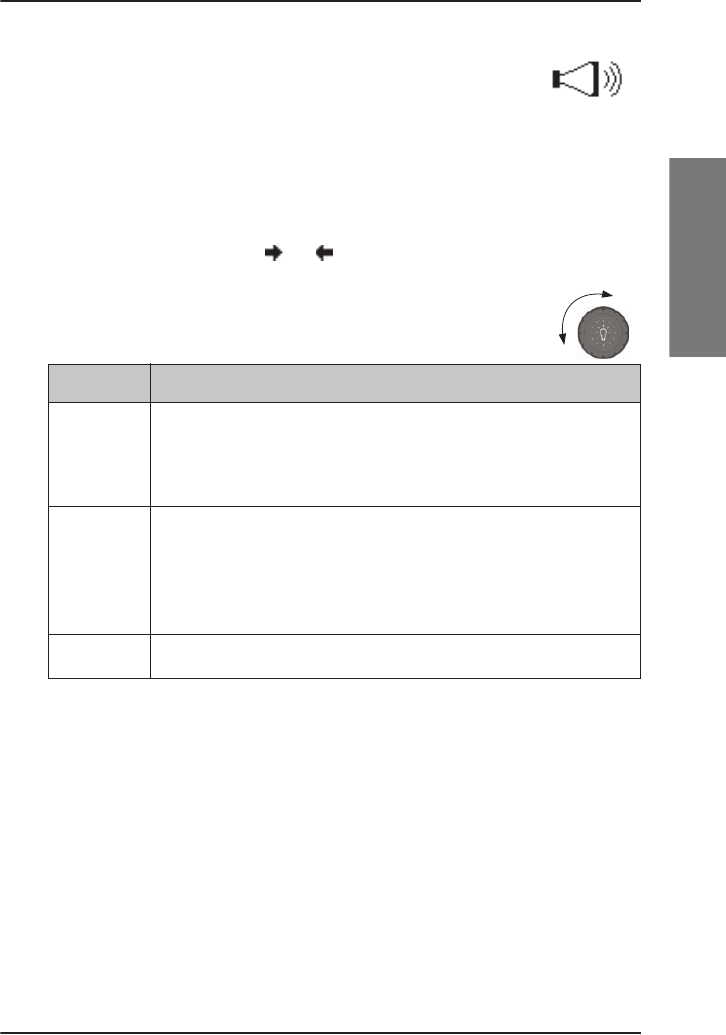
Chapter 2: Operation
Hailer and Fog horn setup 47
2222
Operation
Hailer and Fog horn setup
To change a setting in the HAILER/FOGHORN SETUP, do as follows:
1. Press the soft key SETUP. If it is not in the display, press the soft key MORE
until SETUP appears.
2. Press the arrow soft key or to advance to HAILER/FOGHORN SETUP.
3. Turn the selector wheel knob to go to a setting, then press
the selector wheel knob to change the setting.
4. Press EXIT to return to normal radio operation.
62
Parameter Settings
Hailer
Talk back
OFF - Talk back is disabled (Default).
ON - Talk back is enabled when listening in the hailer PA
mode.
Foghorn
Talk back
OFF - Talk back is disabled if the periodic foghorn is
activated.(Default)
ON - Talk back is enabled if the periodic foghorn is activated,
talk back between horn emissions.
Freq Fog Adjust the foghorn frequency, allowed range: 200-850 Hz.

Chapter 2: Operation
48 Replay function
Replay function
Replay allows the operator to playback received voice messages in the
loudspeaker.
Recording is activated automatically when a signal is received. Recording is
not possible during playback. Up to 60 tracks or 90 seconds can be handled.
The recorded channel is displayed. The message length is shown in seconds.
The display shows how old the message is. If the 90 s storage limit is reached,
the oldest data is overwritten.
Replaying recorded messages
To replay a message do as follows:
1. Press the Replay button (short press). The latest message
(message) is repeated. Information about this message is
shown in the display.
2. To stop replaying the message press the soft key STOP.
3. To play the current message again from the start press the Replay button
(short press).
4. To track back the series of messages double-press the Replay button (short
press) until the desired track is shown. The selected track is played.
5. To track back in time press and hold the Replay button until the desired
point in time. All messages up to the newest will be played.

49
Chapter 3
3333
Installation
Installation 3
In this chapter you find information and guidelines for:
•Unpacking the SAILOR 6216 VHF DSC
•Installing the VHF radio
•Power, VHF antenna and external equipment
Unpacking the SAILOR 6216 VHF DSC
The following items are included in the delivery of a SAILOR 6216 VHF DSC:
•SAILOR 6216 VHF DSC
• SAILOR 6202 Handmicrophone with spiral cable
• User and installation manual (this manual)
• Installation guide
• Mounting bracket with two wheel knobs
• Connectors for cables
• Power cables, fittings and fuses
• Packaging material
• Sun screen (click-on) for front plate protection
• Kit for flush mount installation, including gasket
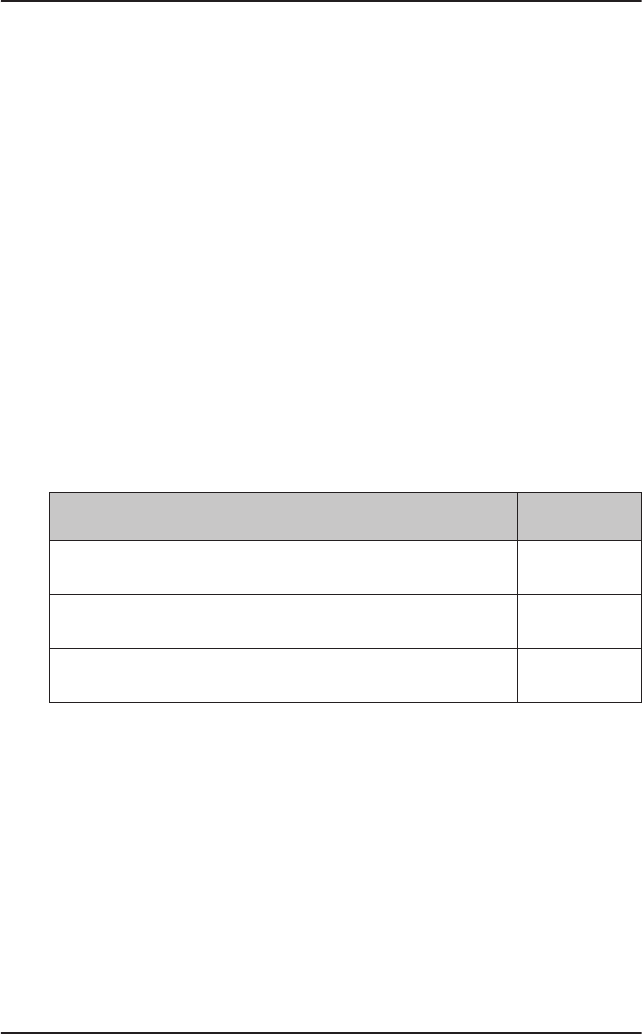
Chapter 3: Installation
50 Installing the VHF radio
Installing the VHF radio
You can mount the VHF radio as a desktop, overhead or flush-mounted unit
integrated in the instrument panel.
Provide space enough to access the front panel connectors and for installing a
cradle for the speaking device.
Provide at least 120 mm space at the back of the SAILOR 6216 VHF DSC radio to
allow free air circulation.
Compass safe distance
Make sure that the VHF radio is far enough from any magnetic compass to
avoid influence of the loudspeaker magnet on the compass reading. See the
following table for the safe distance after magnetization between the nearest
point of the device and the centre of the compass at which it will produce a
deviation of 0.3°.
Device Safe distance
SAILOR 6216 VHF DSC 1.0 m
SAILOR 6202 Handmicrophone 0.8 m
SAILOR 6209 Accessory Connection Box (optional) 0.6 m
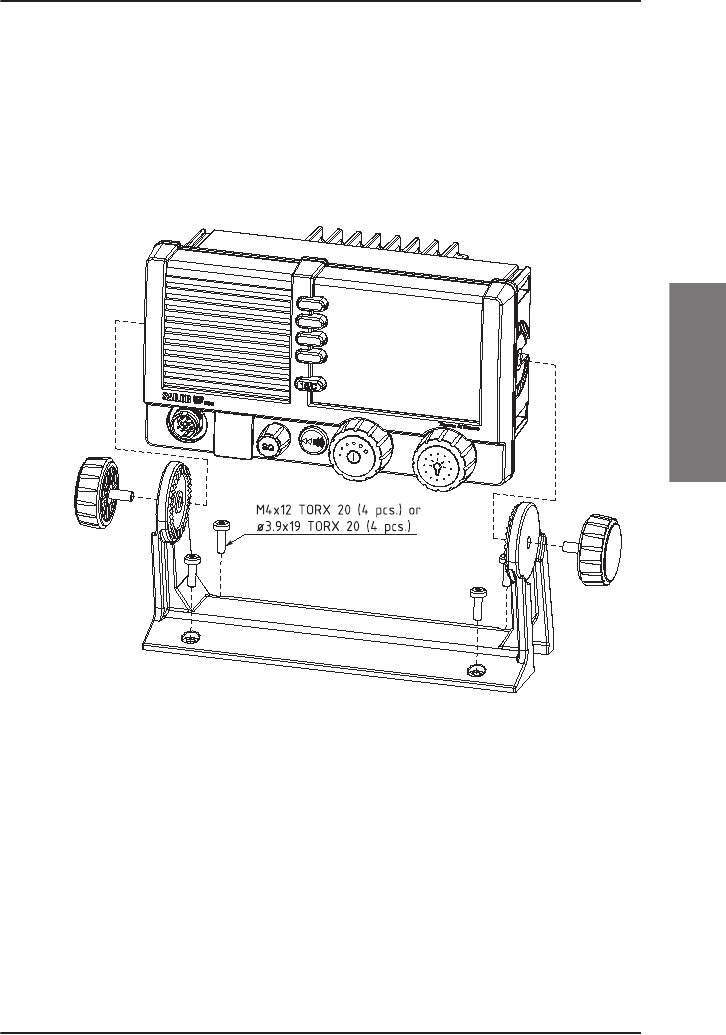
Chapter 3: Installation
Installing the VHF radio 51
3333
Installation
SAILOR 6216 VHF DSC with U mounting bracket
The mounting bracket and two knobs are included in the delivery.
Desktop mounting
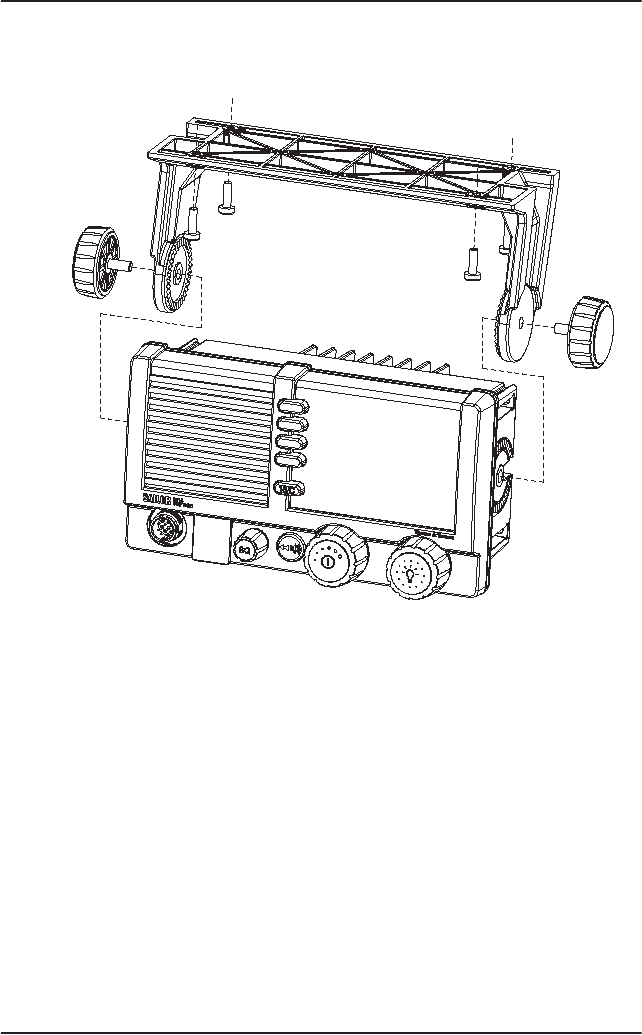
Chapter 3: Installation
52 Installing the VHF radio
Overhead mounting
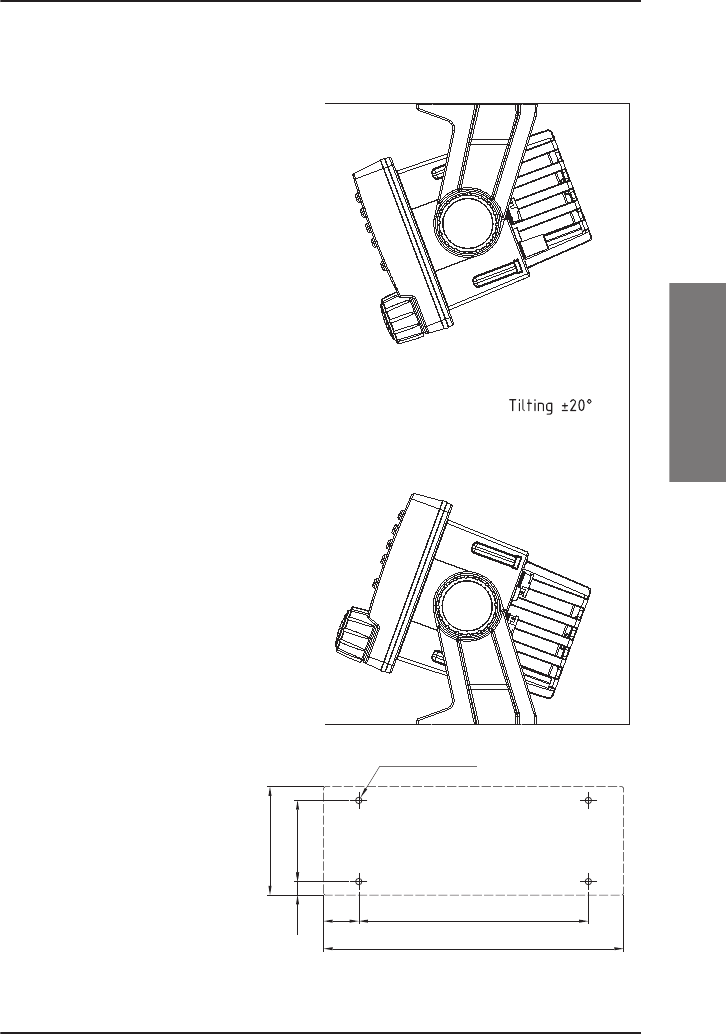
Chapter 3: Installation
Installing the VHF radio 53
3333
Installation
Mounting with U mounting bracket
To mount the VHF radio
as tabletop, do as
follows:
1. Find a suitable
location for the VHF
radio. Check that the
space is wide/deep
enough to
accommodate the
VHF radio.
2. Fasten the bracket
with 4 screws
(included in the
delivery.)
3. Insert the VHF radio
in the bracket and
fasten it with the two
knobs.
4. The display of the
VHF radio should be
at an angle of
approximately 90° to
your line of sight
when operating it.
99-130249
4 x M4 or hole for
self-tapping ø3.9
150mm
53mm
71mm
196mm
23mm
9mm
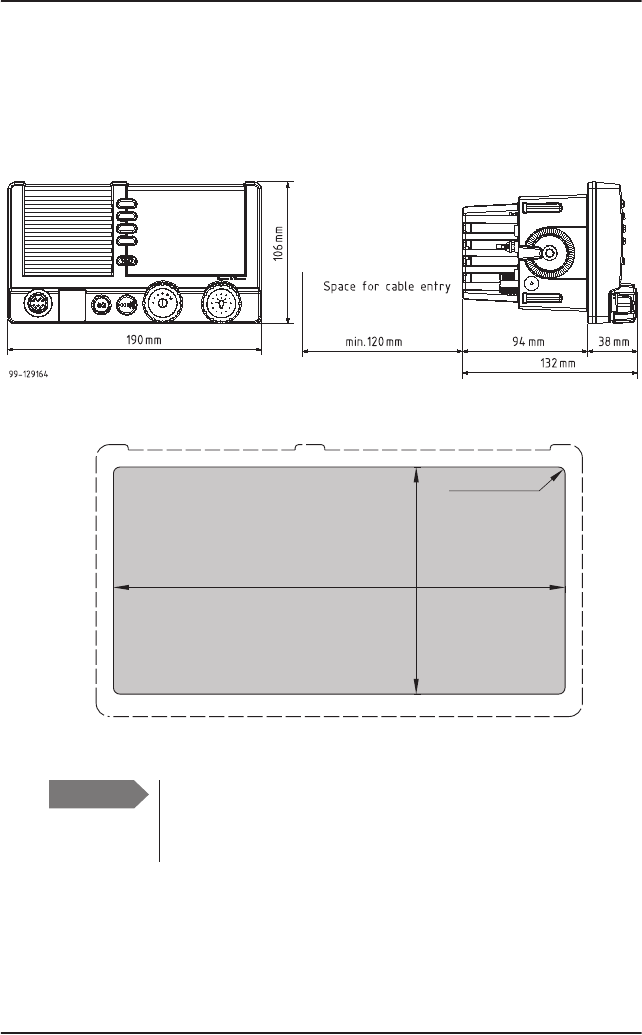
Chapter 3: Installation
54 Installing the VHF radio
SAILOR 6216 VHF DSC for flush mount
You can mount the VHF radio to a flat surface, e.g. an instrument panel. The
flush mount installation kit is included in the delivery.
Important
The scaling in the above drawing is not 1:1. Consequently do
not attempt to use a print or copy of this page without checking
the dimensions.
Remove material from shaded area only!
89mm
177mm
R2.5mm x 4
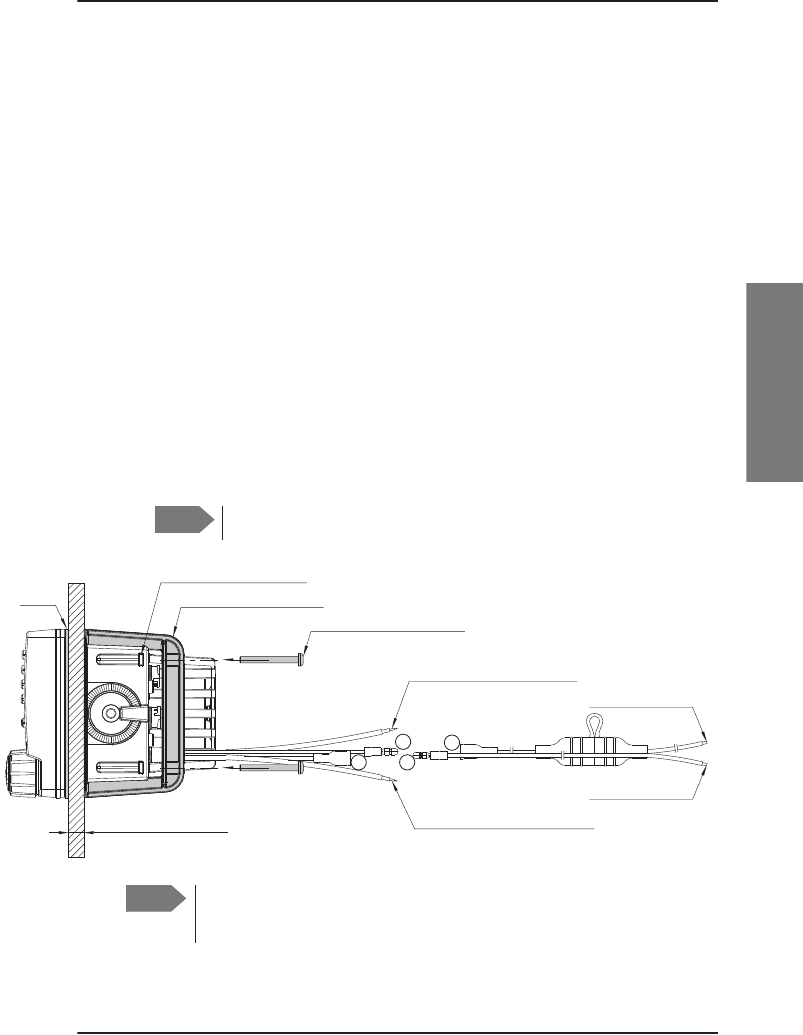
Chapter 3: Installation
Installing the VHF radio 55
3333
Installation
1. Find a suitable location for the VHF radio. Check that the space is deep
enough to accommodate the VHF radio and an additional min. 120 mm
space for cable entry.
2. Keep free distance to allow free air circulation around the VHF radio and to
allow sufficient space for access to cables, see the drawing on this page.
3. Cut out the hole for the VHF radio where you want to mount it. Use the
cutting template in the installation guide.
4. Mount the 4 square nuts M4 in the cabinet, ensure that they are placed
correct so it's possible to screw in the M4x45 screws.
5. Ensure that the flush mount gasket is placed correct on the VHF radio.
6. Before mounting the VHF radio be aware that the surface is plane and
rigid. If the surface is not plane and/or rigid (stiff) remove the gasket and
seal with silicone sealant between the VHF radio and the surface.
7. Slide the VHF radio in the cut-out. Place the flush mount bracket and fasten
it with the 4 screws M4x45. Make sure the torque does not exceed 1Nm
when fastening the screws.
.
Note
Only use screws supplied with the kit for flush mounting.
AA
BB
99-130248
Gasket
Flush Mount Bracket (2 pcs.)
Screw M4x45 TORX 20 (4 pcs.)
Connect to LOUD HAILER
(RED isolation on inner connector)
Connect to EXT. SPEAKER
(WHITE isolation on inner connector)
Connect to POWER +
(RED wire)
Connect to POWER -
(BLUE wire)
Square Nut M4x7x2.2 (4 pcs.)
Max wall thickness 26mm
Note
Firmly tie back and secure any wires not used to avoid the possibility
for mutual shorting or shorting to ground.
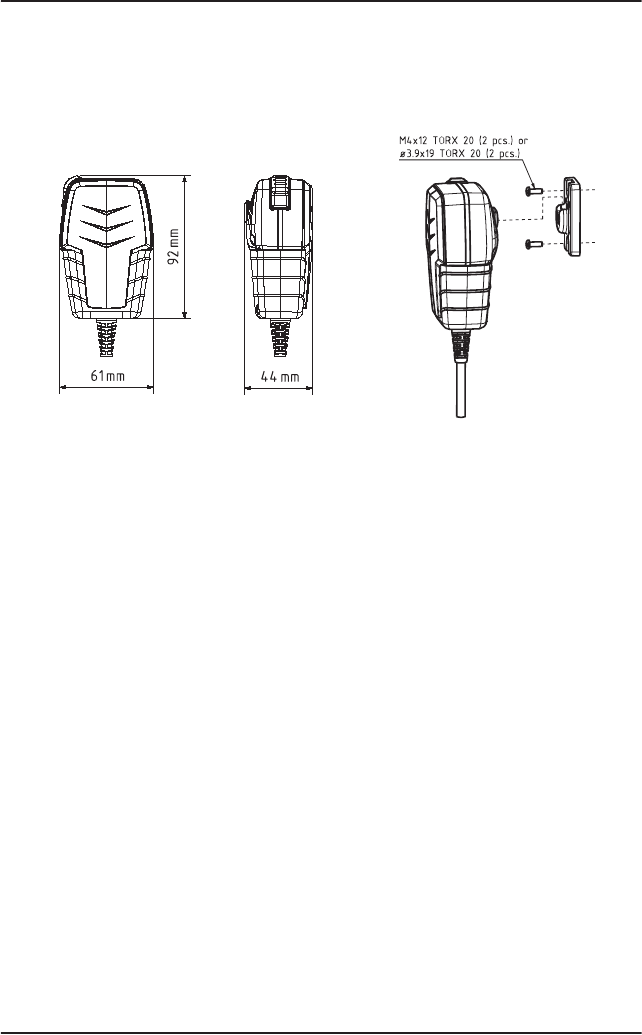
Chapter 3: Installation
56 Installing the VHF radio
SAILOR 6202 Handmicrophone
Handmicrophone with spiral cable and PTT button.
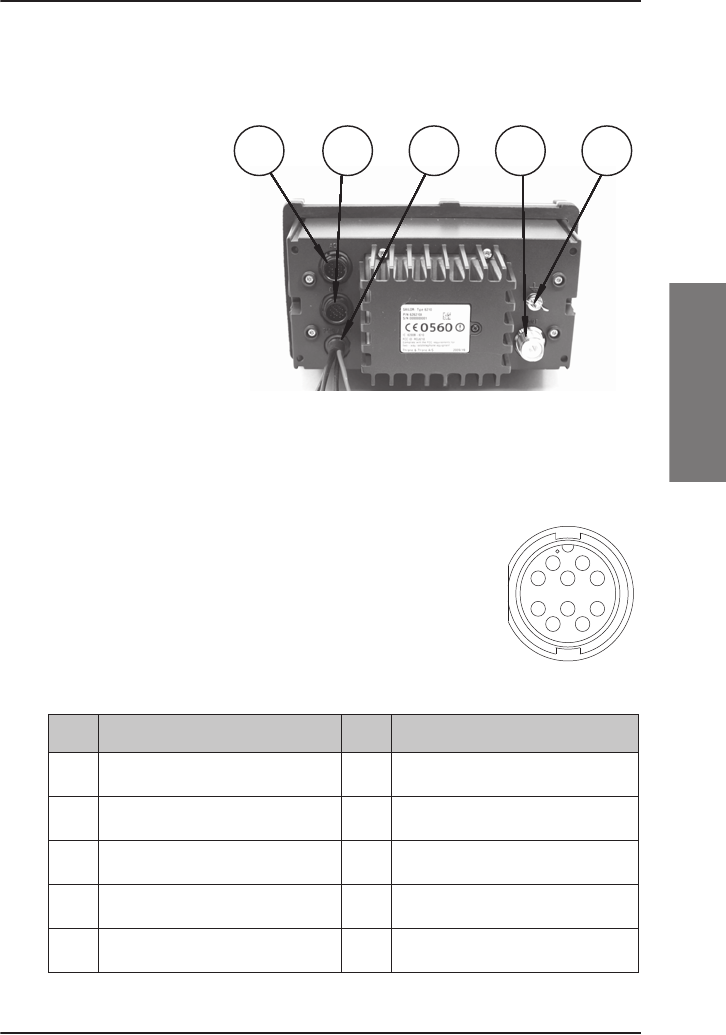
Chapter 3: Installation
Power, VHF antenna and external equipment 57
3333
Installation
Power, VHF antenna and external equipment
1. ACC connector
2. CTRL connector
for control
speaker
microphone
3. Power,
Loudhailer,
foghorn and
external speaker
4. VHF antenna
5. Ground stud
ACC connector
Use the connector marked ACC to connect GPS input.
The interface for GPS is NMEA 0183 (EN61 162-1 Listener
/ EN61 162-2 Talker).
Connector type: Circular connector, 10pin.
Connection cable with plug, part number 406209-941.
Pin assignment: Connector front view on the VHF radio.
2
13 4 5
Pin Description Pin Description
1NMEA in+ 6EAR 2
2 NMEA in- 7 Hook_PTT
3 NMEA out+ 8 Bat_SW Supply Volt when on
4 NMEA out- 9 Internal GND = - Battery
5 Mike 2 10 Internal GND = - Battery
1
2
3
4
10
5
6
7
8
9
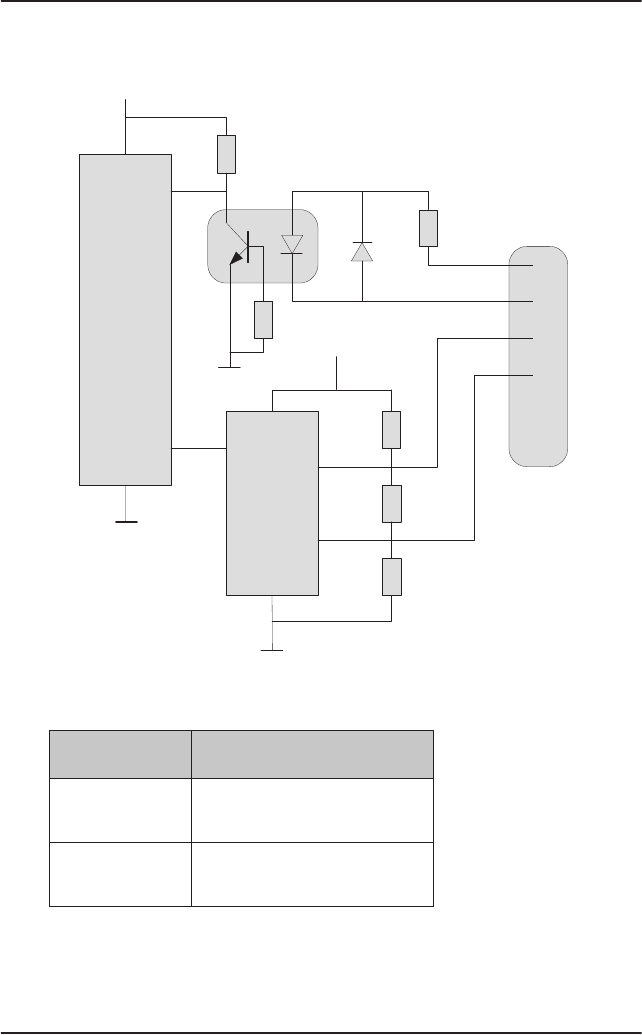
Chapter 3: Installation
58 Power, VHF antenna and external equipment
NMEA interface description
The NMEA interface supports NMEA 0183 v2.0, v2.1 and v2.3.
uP
U43
464k
500R
681R 120R 681R
4k42
U20
NMEA Driver
U43
U24
ACC connector
O pin4
O pin1
O pin2
O pin3
O
Vcc
Vcc
NMEA in+
NMEA in-
A
B
NMEA out+
NMEA out-
J4
NMEA interface Specifications
NMEA input: Impedance: 600 Ohm
Max. 2mA at min. level of 2V
NMEA output Load Impedance: > 60 Ohm
Drive load: < 35 mA

Chapter 3: Installation
Power, VHF antenna and external equipment 59
3333
Installation
The following sentences are supported:
• FSI: All fields are decoded
• GGA: UTC, "Position", "quality indicator". All other fields are unused
• GLL: UTC, "Position", "Status" and "mode". All other fields are unused
• GNS: UTC, "Position" and "mode". All other fields are unused
• RMC: UTC, "Position", "Status", "Date" and "mode". All other fields are
unused
• ZDA: UTC, "Day", "Month", and "Year". All other fields are unused
In accordance to the standard EN61162-1:2008 and EN61162-2:1998
Received NMEA sentences except for FSI can be forwarded to NMEA output. As
talker the sentences are streamed with no intervals.
HW revision: 57-127368-D.02
SW revision: 2.00.01
CTRL connector for control speaker microphone
Connector type: Circular connector, 12pin.
Pin assignment: Connector front view on the VHF radio:
Pin Description Pin Description
1 GND for cable screen 7 Internal GND = - Battery
2 Internal GND=- Battery 8 not used
3 Bat_SW Supply Voltage when on 9 RX out +
4 Bat_SW Supply Voltage when on 10 RX out -
5CAN+ 11TX in +
6CAN- 12TX in -
1
2
11
3
4
10
12
5
6
7
8
9
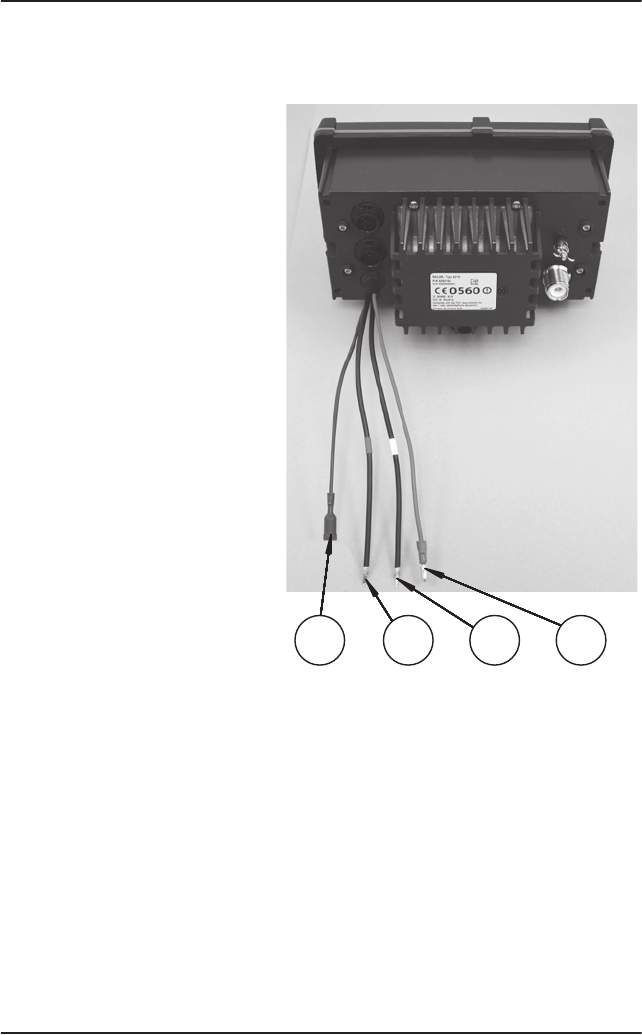
Chapter 3: Installation
60 Power, VHF antenna and external equipment
Power, Loudhailer, foghorn and external speaker
Use the connector marked
PWR/EXT to connect power,
loudhailer and an external
speaker. The cable for this
connector is part of the
delivery.
1. Blue wire: Power -
2. Red isolation on inner
connector: loudhailer
3. White isolation on inner
connector: external
speaker
4. Red wire: Power +
2
13 4
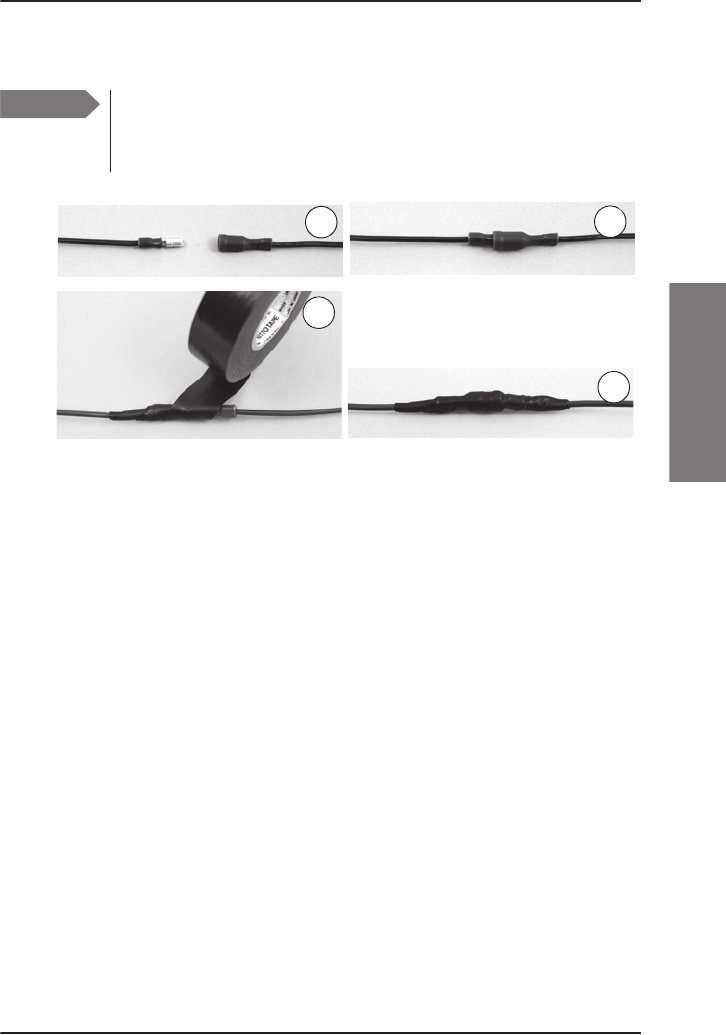
Chapter 3: Installation
Power, VHF antenna and external equipment 61
3333
Installation
Protection against water ingress
VHF antenna
Use the connector marked ANT to connect the VHF antenna to the radio with a
50 Ohm coaxial cable with low loss, e.g. RG214. Install a PL259 plug at the
cable end.
Place the antenna as high and clear of obstructions as possible. Make sure
that the horizontal distance to metal parts is minimum 1.5 m (5 ft).
Connector type: female SO239 for PL259 plug.
Important
You must protect the cable connection with rubber vulcanizing
tape as shown in the pictures below. This protection prevents
water seeping into the VHF radio, cable and connectors.
12
3
4
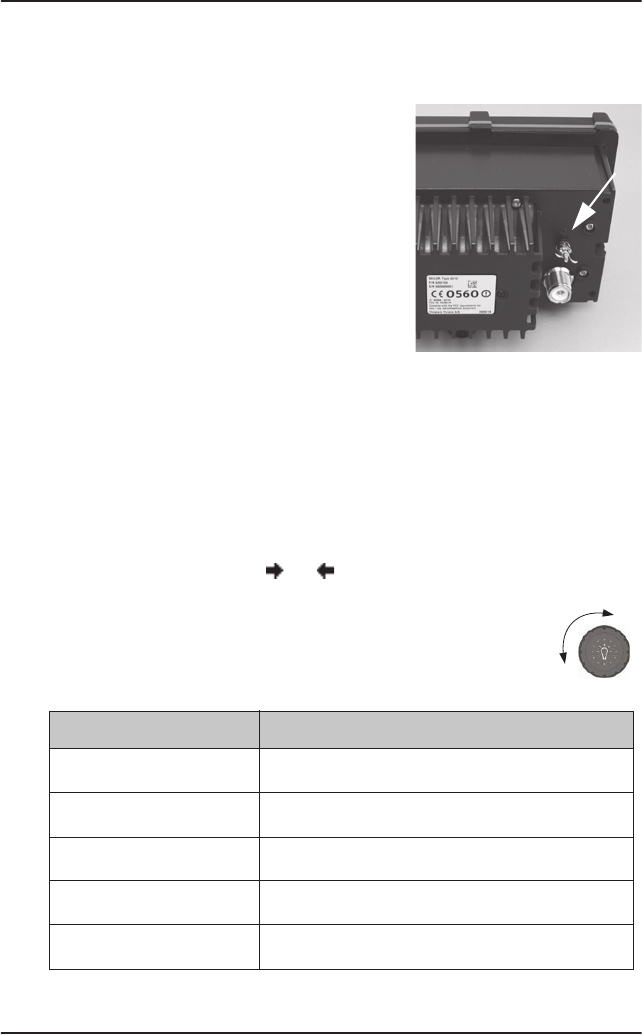
Chapter 3: Installation
62 System setup
Ground stud
To ground the radio connect a ground wire
from the ground stud of the radio to a
suitable grounding point. Use an
appropriately sized wire. The ground stud is
located above the VHF antenna connector.
System setup
To change a setting in the SYSTEM SETUP, do as follows:
1. Press the soft key SETUP. If it is not in the display, press the soft key MORE
until SETUP appears.
2. Press the arrow soft key or to advance to SYSTEM SETUP.
3. Turn the selector wheel knob to go to a setting, then press
the selector wheel knob to change the setting.
4. Press EXIT to return to normal radio operation
.
SYSTEM SETUP Description
NMEA input (baud rate) 4800 (default) or 38400
Factory Defaults Resets the radio to factory defaults
System time & Date View and set system time and date
SW version Software version of the radio
S/N Serial number of the radio

Chapter 3: Installation
System setup 63
3333
Installation
Inactivity timeout Inactivity time-out to exit functions (e.g. in
setup) and return to the application.
Range: 1 to 30 minutes, in 1 minute steps
Default: 10 min.
Password If you need to change the identity of the radio
(MMSI number or ATIS code), contact your
local dealer.
SYSTEM SETUP Description
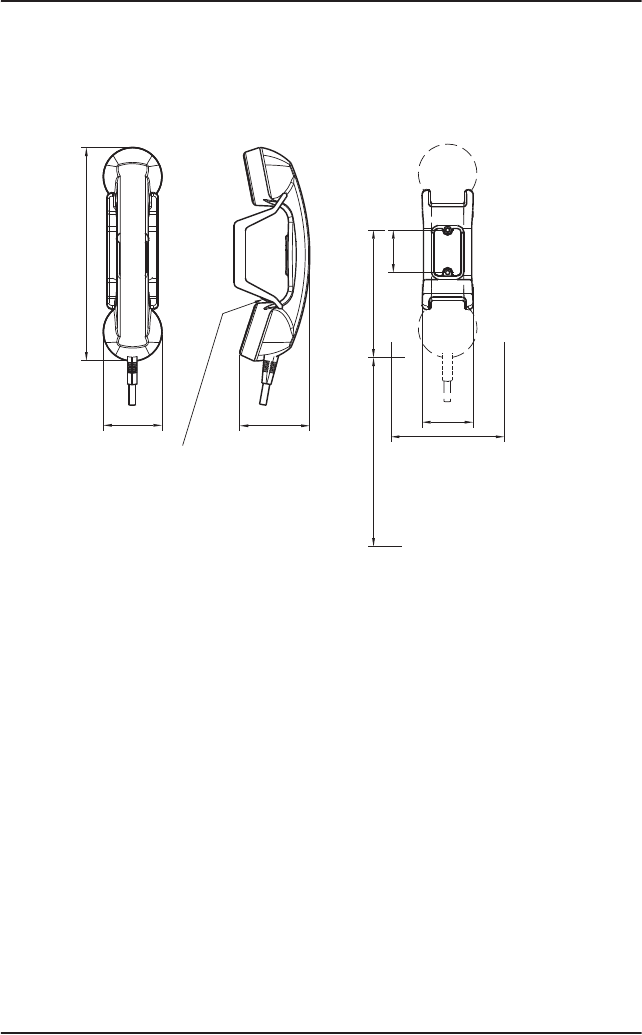
Chapter 3: Installation
64 SAILOR 6201 Handset cradle (optional)
SAILOR 6201 Handset cradle (optional)
This Handset has a hook-on/off function,
which is activated by a small magnet embedded
in the cradle.
The cradle must be installed as illustrated in
order to ensure the hook-on/off functionality
of the Handset.
75
62
226
* 120
min. 100
Space for handset access
Space for cable and handset cable
54
45
135
39655C
Drilling plan

65
Chapter 4
4444
Service & maintenance
Service & maintenance 4
Contact for support
Contact your authorized dealer for technical service and support of the VHF
radio. Before contacting your authorized dealer you can go through the
troubleshooting guide to solve some of the most common operational
problems.
Maintenance
Preventive maintenance
Maintenance of the SAILOR 6216 VHF DSC radio can be reduced to a
maintenance check at each visit of the service staff. Inspect the radio for
mechanical damages, salt deposits, corrosion and any foreign material. Due to
its robust construction and ruggedness the radio has a long lifetime. Anyway it
must carefully be checked at intervals not longer than 12 months - dependent
on the current working conditions.
Salt deposits
In case the equipment has been exposed to sea water there is a risk of salt
crystallization on the keys and wheel knobs and they may become inoperable.
Clean the VHF radio and speaker microphones with fresh water.
Error messages and warnings
Errors and warning messages are shown in the display and are read-only.
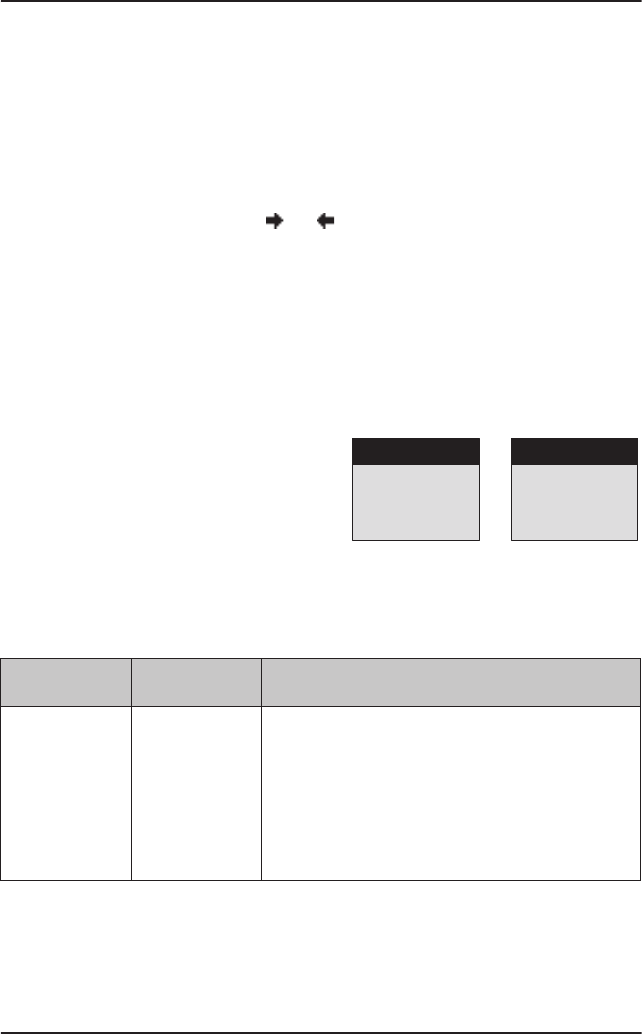
Chapter 4: Service & maintenance
66 Maintenance
DSC self test
To run a control routine DSC self test, do as follows:
1. Press the soft key SETUP. If it is not in the display, press the soft key MORE
until SETUP appears.
2. Press the arrow soft key or to advance to DSC SETUP.
3. Turn the selector wheel knob to select DSC Self Test. Press and turn the
selector wheel knob to select RUN.
The test will check the ability to encode/decode DSC signalling on RF level.
The radio will automatically transmit a DSC safety test call to its own MMSI
number without enabling the transmitter power amplifier. In parallel the
radio decodes and compares the received call to be the same as the
transmitted.
The display shows the result of
the test.
4. Press the soft key OK to
acknowledge the test result and
resume normal operation.
Troubleshooting guide
DSC loopback
test passed
TEST RESULT
DSC loopback
test FAILED
TEST RESULT
Action Symptom Remedy
The radio will
not turn on
The display is
empty.
Check if power is present.
Check fuse which is placed in the + supply
wire.
Check performance of power supply if
connected to one.

Chapter 4: Service & maintenance
Maintenance 67
4444
Service & maintenance
No commu-
nication
The
loudspeaker
is mute.
Check the antenna installation.
Check antenna cable.
Check handset/Handmicrophone and cable.
GPS Position
requested.
If the VHF, despite being connected to a
GPS/position source, prompts for entering the
position and time information, the automated
update has most likely been lost either due to
missing data on the line, broken cabling or the
GPS/position source has failed. Refer to the
installation section in the back of this manual
for installation and connection details.
Until the automatic position update from
GPS/position source is restored position and
time must be entered manually when
prompted by a (four hour) timer in VHF.
In the DSC SETUP, Position Info, you can verity
the position data. If data is present
Lat/Lon/UTC will be displayed.
Action Symptom Remedy

Chapter 4: Service & maintenance
68 Maintenance
DSC routine
testing
Check the DSC function regularly. Verify the
complete DSC installation, with antennas, by
transmitting a Safety Test call to another
station (coast or ship). The test call is
generated using the DSC call flow via menu
CALL.
The call should normally be replied by the
receiving station without questioning. The
default configuration of a SP6215/16 is auto-
acknowledgement of any received Safety test
call requests. If a ship is equipped with
multiple radios a second radio can be the
station to check up against. The transmitting
radio will not receive its own transmitted calls.
If there is only a single radio on a vessel, a
facility is built into the unit where the DSC
engine can be verified using a test call that is
internally looped without activating the radio
transmitter PA. The test is executed via menu
SETUP, DSC SETUP. The call sequence that is
verified, is an Individual Safety Test Call
directed to own MMSI. The test status is read
in the display.
Missing
MMSI
DSC
operation is
not working
When powering up the VHF for the first time
after leaving factory there is no MMSI number
in the VHF radio. For the DSC operation to
function the MMSI number must be entered in
the VHF radio. For further details see Entering
the MMSI number on page 7.
Action Symptom Remedy

Chapter 4: Service & maintenance
Maintenance 69
4444
Service & maintenance
Radio time DSC logs are
sorted with
wrong time
stamp or
radio time is
incorrect
A wrong radio time indication should occur
only if GPS position source is not connected or
providing correct time data. A valid GPS time
signal will update the UTC time used for time
stamping the DSC logs.
If a GPS/position source is not connected to
the VHF radio and hence position and time is
entered manually, you must enter the "radio
time" also manually, at least after power up.
This will ensure correct time stamping of the
DSC logs.
The UTC time is the suggested time to be
entered when prompted for entering position
and time manually (every four hours).
DSC Channel
not free
DSC
transmission
delayed
The transmission of a DSC call which is not of
category distress or urgency will be postponed
if the VHF radio is in the process of decoding
an incoming DSC call. As soon as this decoding
process has finalized the transmission will take
place.
Handset
configuration
No sound in
earpiece
The earpiece volume may be configured to
OFF. See section Controller setup on page 10
on how to adjust the earpiece volume of the
handset.
Action Symptom Remedy
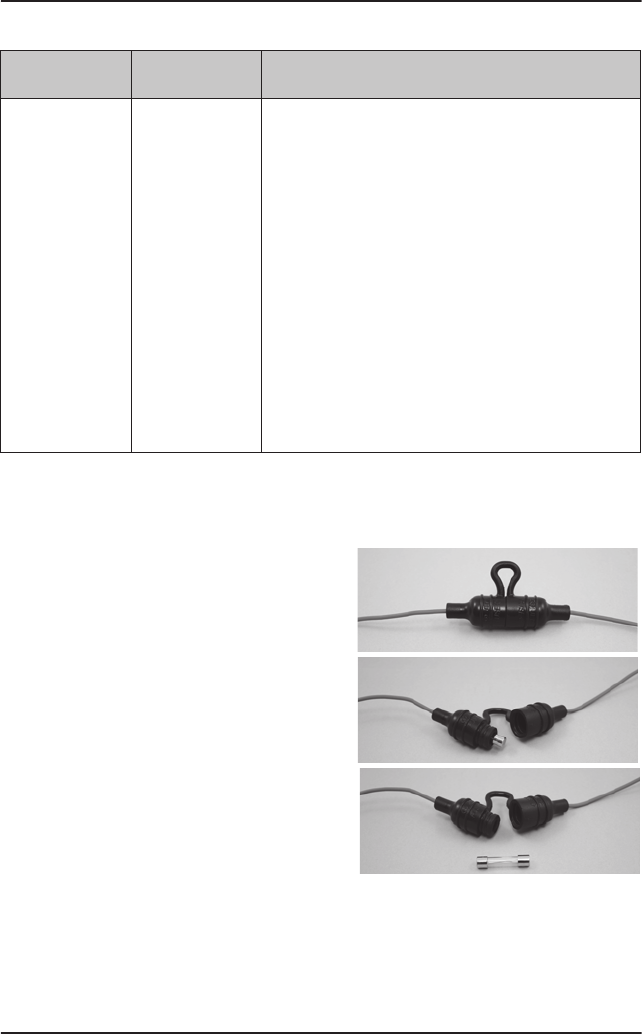
Chapter 4: Service & maintenance
70 Maintenance
Replacing the fuse in the red wire (Power +)
One fuse is installed in the supplied
DC cable. If the fuse is blown, track
down why the fuse was blown and
solve the problem. To replace the
fuse, do as follows:
1. Hold both ends of the fuse holder
and pull it apart.
2. Take out the old fuse.
3. Insert the new fuse. The fuse
rating is 10 AT.
4. Make sure that the fuse is tightly
fixed on the metal contact inside
the fuse holder.
5. Put together the fuse holder.
Device failure If any of the checks and tests described in this
section do not assist in resolving the
difficulties experienced in the operation
and/or performance of the VHF installation, a
fault may have developed in the VHF radio
itself.
When contacting an authorized Thrane &
Thrane representative be sure to provide as
much information as possible describing the
observed behavior - also including the type of
the VHF radio, its serial number, and software
release version (both found in the setup menu
Controller Setup).
Action Symptom Remedy
1
2
3
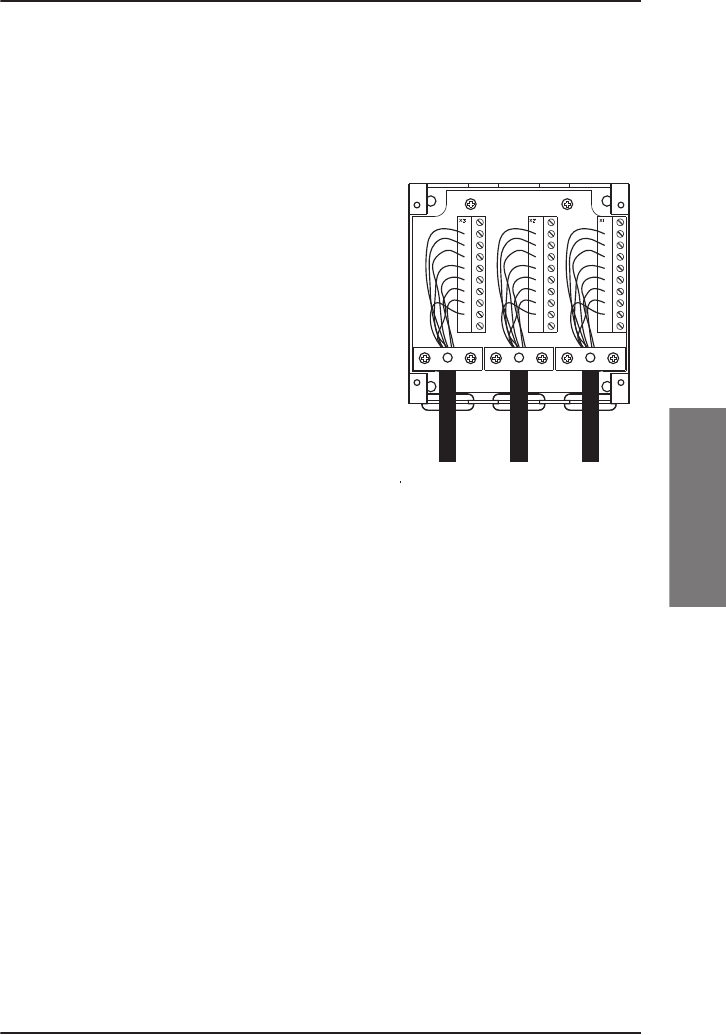
Chapter 4: Service & maintenance
Equipment and accessories 71
4444
Service & maintenance
Equipment and accessories
SAILOR 6209 Accessory connection box
You can connect the SAILOR 6209
Accessory Connection Box for input from
GPS (NMEA) and SAILOR 6201 Handset
option.
The wire terminal blocks are connected in
parallel.
Warranty
For repair or replacement of the VHF radio within terms of warranty, contact
your local dealer.
36090

Chapter 4: Service & maintenance
72 Warranty

73
Appendix A
AAAA
Technical specifications
Technical specifications A
T
Item Specification
Weight SAILOR 6216 transceiver
unit
approx. 2,65 lbs
Weight SAILOR 6216 transceiver
unit
approx. 3,31 lbs including SAILOR 6202
Handmicrophone and mounting bracket
Dimensions Height: Outer dimension 106 mm, hole height
for flush mount 89 mm
Width: Outer dimension 190 mm, hole width
for flush mount 177 mm
Depth: Outer dimension from front of wheel
knobs 132 mm, depth for flush mount 94 mm
Operating temperature 5°F to 131°F
Storage temperature -40°F to 176°F
Power supply 12 VDC Nominal (10,8– 15,6 VDC)
Current consumption Max. 7 A
Frequency range TX 156,000-161,450,
RX 156,000-163.425 MHz
Channel spacing 12,5 kHz and 25 kHz, all international
maritime channels

Appendix A: Technical specifications
74
Number of P channels The radio may be programmed with up to 40
private channels that can be managed in all
channel modes.
Transmit power Hi/Lo: 25 W and <1 W
RF output power 25 W +0 dB / - 1.5 dB
1W +0dB / - 1.5dB
RF output power, Canada 21 W ±0.75 dB / 0.8 W ±0.75 dB
Modulation
25 kHz
12.5 kHz
16K0G3E
8K05G3E
LF power Built-in loudspeaker: 6 W
External loudspeaker: 6 W / 8 Ohm
Loudhailer: 30 W / 4 Ohm (when the unit is
not transmitting)
Receiver sensitivity < -119 dBm typically @ 20 dB SINAD CCITT
weighted
Antenna 50 Ohm antenna, 50 Ohm female SO239 for
PL259 plug
1-antenna operation for VHF and DSC
communication
Water ingress IPx8 and IPx6 all over. For flush-mount
installations a sealing gasket is included in
the delivery.
Item Specification
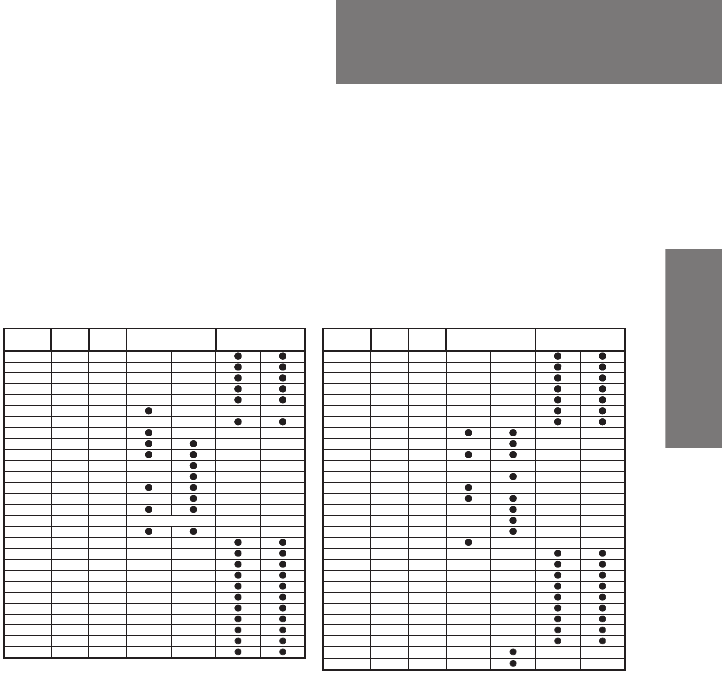
75
Appendix B
BBBB
Maritime channels
Maritime channels B
International channels
L) 1 W TX power
*) Channel 87 and 88 became simplex channels following the introduction of
AIS1 at 161.975 MHz and AIS2 on 162.025 MHz.
These are the default channels. Additional narrowband channels can be
enabled, see Radio setup on page 22.
Channels TX RX SIMPLEX DUPLEX Channels TX RX SIMPLEX DUPLEX
MHz MHz Intership Port Port Public MHz MHz Intership Port Port Public
1 156,050 160,650 60 156,025 160,625
2 156,100 160,700 61 156,075 160,675
3 156,150 160,750 62 156,125 160,725
4 156,200 160,800 63 156,175 160,775
5
156 250
160 850
64
156 225
160 825
5
156
,
250
160
,
850
64
156
,
225
160
,
825
6 156,300 156,300 65 156,275 160,875
7 156,350 160,950 66 156,325 160,925
8 156,400 156,400 67 156,375 156,375
9 156,450 156,450 68 156,425 156,425
10 156,500 156,500 69 156,475 156,475
11 156,550 156,550 70 156,525 156,525 DSC DSC
12
156 600
156 600
71
156 575
156 575
12 156,600 156,600 71 156,575 156,575
13 156,650 156,650 72 156,625 156,625
14 156,700 156,700 73 156,675 156,675
15 156,750 156,750 74 156,725 156,725
16 156,800 156,800 Distress and calling 75 156,775 156,775 L)
17 156,850 156,850 76 156,825 156,825 L)
18 156,900 161,500 77 156,875 156,875
19 156,950 161,550 78 156,925 161,525
20 157,000 161,600 79 156,975 161,575
21 157,050 161,650 80 157,025 161,625
22 157,100 161,700 81 157,075 161,675
23 157,150 161,750 82 157,125 161,725
24 157,200 161,800 83 157,175 161,775
25 157
,
250 161
,
850 84 157
,
225 161
,
825
25
157
,
250
161
,
850
84
157
,
225
161
,
825
26 157,300 161,900 85 157,275 161,875
27 157,350 161,950 86 157,325 161,925
28 157,400 162,000 87 157,375 157,375 *)
88 157,425 157,425 *)
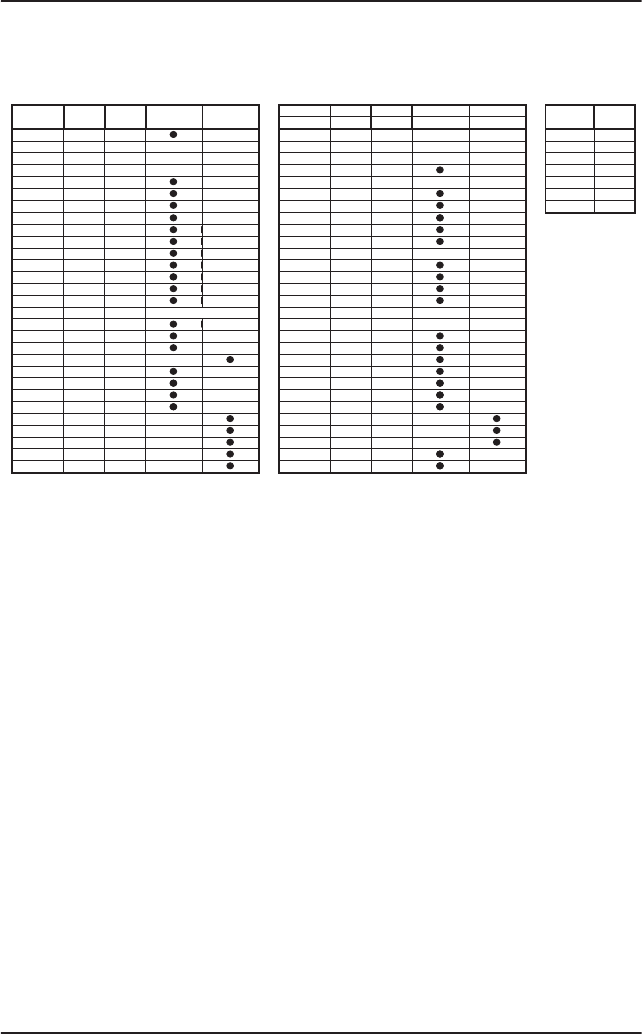
Appendix B: Maritime channels
76
US channels
L) 1 W TX power. Channels 13, 67 and 77 are limited to low transmission
power.
B) Channels 2, 3, 4, 60, 61, 62, 64, 75 and 76 cannot be selected in US mode.
!) Channels 21A, 22A, 23A, 81A, 82A and 83A may be legally used in some
circumstances but not by the general public in US waters.
RX) Only RX: transmissions are blocked.
*) Channels 87 and 88 became simplex channels following the introduction of
AIS1 at 161.975 MHz and AIS2 on 162.025 MHz.
These are the default channels. Additional narrowband channels can be
enabled, see Radio setup on page 22.
Channels TX RX SIMPLEX DUPLEX Channels TX RX SIMPLEX DUPLEX Channels RX
MHz MHz MHz MHz MHz
1A 156,050 156,050 60
B) W1 162,550
2
B) 61 B) W2 162,400
3
B) 62 B) W3 162,475
4
B) 63A 156,175 156,175 W4 162,425
5A 156,250 156,250 64
B) W5 162,450
6 156,300 156,300 65A 156,275 156,275 W6 162,500
7A 156,350 156,350 66A 156,325 156,325 W7 162,525
8 156,400 156,400 67 156,375 156,375
L)
9 156,450 156,450 68 156,425 156,425
10 156,500 156,500 69 156,475 156,475
11 156,550 156,550 70 156,525 156,525
DSC
12 156,600 156,600 71 156,575 156,575
L)
13 156,650 156,650
L) 72 156,625 156,625
14 156,700 156,700 73 156,675 156,675
15B 156,750
RX) 74 156,725 156,725
16 156,800 156,800
Distress and calling 75 B)
17 156,850 156,850 76
B)
18A 156,900 156,900 77 156,875 156,875
19A 156,950 156,950 78A 156,925 156,925
20 157,000 161,600 79A 156,975 156,975
20A 157,000 157,000 80A 157,025 157,025
21A 157,050 157,050
!) 81A 157,075 157,075 !)
22A 157,100 157,100 !) 82A 157,125 157,125
!)
23A 157,150 157,150
!) 83A 157,175 157,175 !)
24 157,200 161,800 84 157,225 161,825
25 157,250 161,850 85 157,275 161,875
26 157,300 161,900 86 157,325 161,925
27 157,350 161,950 87A 157,375 157,375
*)
28 157,400 162,000 88A 157,425 157,425 *)
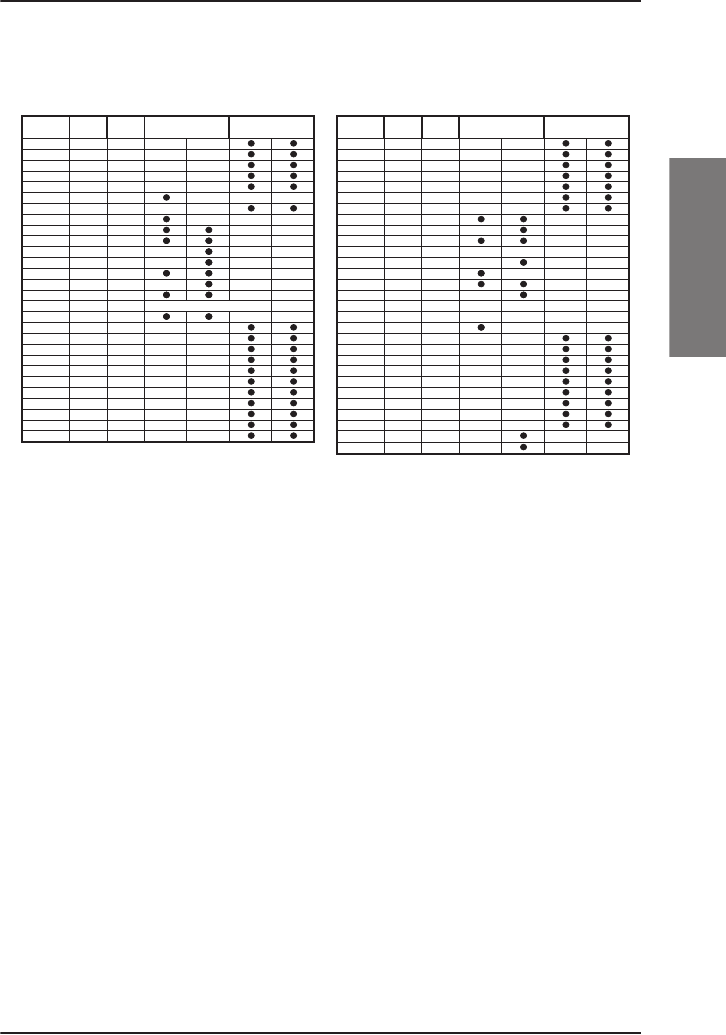
Appendix B: Maritime channels
77
BBBB
Maritime channels
Bi channels
L) 1 W TX power on channels 6, 8, 10, 11, 12, 13, 14, 15, 17, 71, 72, 74 and 77.
B) Channels 75 and 76 cannot be selected in BI mode.
*) Channels 87 and 88 became simplex channels following the introduction of
AIS1 at 161.975 MHz and AIS2 on 162.025 MHz.
NB! The ATIS function is enabled on all channels.
Dual Watch & Scanning modes are disabled.
Channels TX RX SIMPLEX DUPLEX Channels TX RX SIMPLEX DUPLEX
MHz MHz Intership Port Port Public MHz MHz Intership Port Port Public
1 156,050 160,650 60 156,025 160,625
2 156,100 160,700 61 156,075 160,675
3 156,150 160,750 62 156,125 160,725
4 156,200 160,800 63 156,175 160,775
5 156,250 160,850 64 156,225 160,825
6 156,300 156,300
L) 65 156,275 160,875
7 156,350 160,950 66 156,325 160,925
8 156,400 156,400
L) 67 156,375 156,375
9 156,450 156,450 68 156,425 156,425
10 156,500 156,500
L) L) 69 156,475 156,475
11 156,550 156,550
L) 70 156,525 156,525 DSC DSC
12 156,600 156,600
L) 71 156,575 156,575 L)
13 156,650 156,650
L) L) 72 156,625 156,625 L)
14 156,700 156,700
L) 73 156,675 156,675
15 156,750 156,750
L) L) 74 156,725 156,725 L)
16 156,800 156,800
Distress and calling 75 B)
17 156,850 156,850
L) L) 76 B)
18 156,900 161,500 77 156,875 156,875
L)
19 156,950 161,550 78 156,925 161,525
20 157,000 161,600 79 156,975 161,575
21 157,050 161,650 80 157,025 161,625
22 157,100 161,700 81 157,075 161,675
23 157,150 161,750 82 157,125 161,725
24 157,200 161,800 83 157,175 161,775
25 157,250 161,850 84 157,225 161,825
26 157,300 161,900 85 157,275 161,875
27 157,350 161,950 86 157,325 161,925
28 157,400 162,000 87 157,375 157,375 *)
88 157,425 157,425 *)
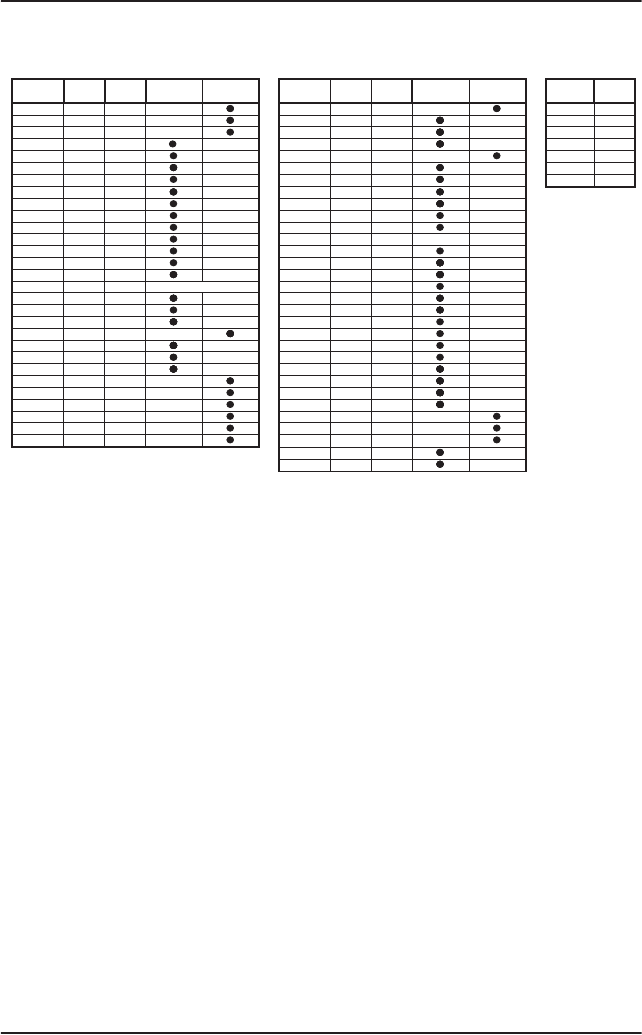
Appendix B: Maritime channels
78
Ca channels
L) 1 W TX power. Channels 15, 17, 20, 65, 66, 75, 76 and 77 are limited to 1 W
transmission power.
!) Channels 4A, 6, 19A, 21A, 22A, 61A, 62A, 63A, 67, 72, 73, 81A, 82A and 83A
may be legally used in some circumstances but not by the general public in
CA waters.
RX) Only RX: transmission is blocked.
*) Channels 87 and 88 became simplex channels following the introduction of
AIS1 at 161.975 MHz and AIS2 on 162.025 MHz.
These are the default channels. Additional narrowband channels can be
enabled, see Radio setup on page 22.
Channels TX RX SIMPLEX DUPLEX Channels TX RX SIMPLEX DUPLEX Channels RX
MHz MHz MHz MHz MHz
1 156,050 160,650 60 156,025 160,625 W1 162,550
2 156,100 160,700 61A 156,075 156,075
!) W2 162,400
3 156,150 160,750 62A 156,125 156,125
!) W3 162,475
4A 156,200 156,200
!) 63A 156,175 156,175 !) W4 162,425
5A 156,250 156,250 64 156,225 160,825 W5 162,450
6 156,300 156,300
!) 64A 156,225 156,225 W6 162,500
7A 156,350 156,350 65A 156,275 156,275 L) W7 162,525
8 156,400 156,400 66A 156,325 156,325
L)
9 156,450 156,450 67 156,375 156,375
!)
10 156,500 156,500 68 156,425 156,425
11 156,550 156,550 69 156,475 156,475
12 156,600 156,600 70 156,525 156,525
DSC
13 156,650 156,650 71 156,575 156,575
14 156,700 156,700 72 156,625 156,625
!)
15 156,750 156,750
L) 73 156,675 156,675 !)
16 156,800 156,800
Distress and calling 74 156,725 156,725
17 156,850 156,850
L) 75 156,775 156,775 L)
18A 156,900 156,900 76 156,825 156,825
L)
19A 156,950 156,950
!) 77 156,875 156,875 L)
20 157,000 161,600
L) 78A 156,925 156,925
21A 157,050 157,050
!) 79A 156,975 156,975
21B 161,650
RX) 80A 157,025 157,025
22A 157,100 157,100
!) 81A 157,075 157,075 !)
23 157,150 161,750 82A 157,125 157,125
!)
24 157,200 161,800 83A 157,175 157,175
!)
25 157,250 161,850 83B 161,775
RX)
26 157,300 161,900 84 157,225 161,825
27 157,350 161,950 85 157,275 161,875
28 157,400 162,000 86 157,325 161,925
87 157,375 157,375
*)
88 157,425 157,425 *)

Chapter B: Maritime channels
79
BBBB
Maritime channels
Alternative channels
If the radio is used in regions where neither of the four described standard
channels are allowed, a reduced channel table with international channel
designators and frequencies can be made. Contact your local dealer for
programming the alternative channels.
Private channels
Up to 40 licensed private channels for non-DSC purposes may be specified.
For programming the private channels contact your local dealer.

Chapter B: Maritime channels
80

81
Glossary
CCCC
Glossary
Glossary C
A
AIS Automatic Identification System, used by ships and Vessel Traffic
Services (VTS) principally for identification and locating vessels.
ATIS Automatic Transmission Identification System
D
DSC Digital Selective Calling
G
GGA NMEA sentence, essential fix data which provide 3D location and
accuracy data.
GLL NMEA sentence, Geographic Latitude and Longitude
GNS NMEA sentence,
GPS Global Positioning System
N
NMEA National Marine Electronics Association, specification for
communication between marine electronic devices
P
PTT Push To Talk
R
RMC NMEA sentence, version of essential gps position, velocity, time
data.

Glossary
82
U
UTC Coordinated Universal Time. The International Atomic Time (TAI)
with leap seconds added at irregular intervals to compensate for
the Earth’s slowing rotation. Leap seconds are used to allow UTC
to closely track UT1, which is mean solar time at the Royal
Observatory, Greenwich.
V
VHF Very High Frequency
Z
ZDA NMEA sentence, date and time.

83
Index
DDDD
Index
Index D
Numerics
16/C, 12
90 s replay, 48
A
ACC connector, 57
accessories, 71
acknowledgement, distress, 27
action line, display, 3
activate
foghorn, 41, 45
scan resume, 22
scanning, 20
watch, 19
ADD, 42
add a contact, 42
adjust
squelch, 9
adjusting
speaker volume, 6
ALT, 79
ALT channel table, 23
ANT connector, 61
ATIS code, 24
change, 63
attenuation control, 18
Auto-Ack Individual, 39
Auto-Ack Test, 39
Auto-switch Channel, 40
B
background sessions
DSC, 37
backlight, 1
dim, 6
Bi, 77
Bi channels, 77
browse channels, 6
C
Ca channels, 78
cable for VHF antenna, 61
CALL, 41
call
Distress procedure, iv
DSC, 25
call channel, program, 15
call log, DSC, 38
CAN channel table, 23
cancelling
distress, 27
change
dual and triple watch, 19
channel
add to scan, 20
naming, 15
program, 15
remove from scan, 20
select, 6
working, 6
channel table
ALT, 23, 79
Bi, 77
Ca, 78
CAN, 23
INT, 75
PRIV, 23, 79
US, 23, 76

Index
84
channels
Bi, 77
Ca, 78
international, 75
primary, 14
private, 15
US, 76
weather, 15
Comm Inactivity, 39
compass safe distance, 50
connector
ACC, 57
ANT, 61
CTRL, 59
external speaker, 60
foghorn, 60
loudhailer, 60
VHF antenna, 61
contact, 65
adding, 42
deleting, 43
editing, 43
controls, front plate, 2
cradle for 6201, installation, 64
CTRL connector, 59
D
deactivate, 46
foghorn, 46
watch, 19
default reset, 62
DELETE, 43
delete contact, 43
delivery, items included, 49
dim, 6
display, 3
distress
acknowledgement, 27
cancelling, 27
display, 26
nature, 26
power failure, 28
received calls, 29
time since activation, 26
distress button, 25
Distress procedure, iv
Distress timeout, 39
document number, this manual, i
DSC
background sessions, 37
call log, 38
calls, 25
multiple calls, 37
session definition, 31
setup, 38
DSC alarms
non distress, 39
DSC headlines, 32
DSC self test, 40
DSC session, 31
typical display, 32
DSC setup, 38
DSC soft keys, 33
dual watch, 22
change to triple, 19
E
editing a contact, 43
emergency calls, iv
enter position manually, 8
error messages, 65

Index
85
DDDD
Index
external speaker
cabling, 60
connector, 60
F
factory defaults, 62
flush mount, 54
FOG, 45
foghorn, 1, 45, 46
activate, 41, 45
connector, 60
patterns, 1
test tone, 46
foghorn frequency, setup, 47
frequency range, VHF, 73
front plate, controls, 2
fuses, how to replace, 70
G
GPS input, 57, 71
GPS position
display, 8
H
HAIL, 44
hand microphone
installing, 56
Handmicrophone, 9
handset cradle
installation, 64
hang time, 22
headline
DSC, 32
HORN, 46
I
input
GPS, 71
handset, 71
NMEA, 62
installation
cradle for 6201, 64
desktop, 51
flush mount, 54
handset cradle, 64
mounting bracket, 53
overhead, 52
INT, 75
IP rating, 74
K
key 16/C, 12
keys on front plate, 2
L
LO/HI, 18
LOCAL, 18
loud hailer, 44
cabling, 60
louder, volume, 6
loudhailer, 1
connector, 60
receiving radio channel, 44
low power
override, 18
low power, overriding, 18
M
manual, document number, i

Index
86
maritime channels, 75
MAYDAY, iv
message
replay, 48
MMSI
change, 63
MMSI number
reviewing, 8
MORE, 10
mounting, 50
flush mount, 54
with mounting bracket, 53
multiple calls, DSC, 37
mut
speaker, 9
N
NAME, 15
name a call channel, 15
nature of distress, 26
night vision, how to dim, 6
NMEA, 57
NMEA input, 62
NMEA interface, 58
Non-dist Inactivity, 39
Non-distr.alarms, 39
O
overriding low power, 18
P
PA
talk-back, 44
password, 63
PBOOK, 41
phone book, 41
add contact, 42
delete a contact, 43
edit a contact, 43
position
enter manually, 8
position data
enter manually, 39
position Info, 39
power failure
distress, 28
power fuse, 70
power off, 6
power on, 6
power, cabling, 60
primary channel, program, 15
priority scan, 23
PRIV, 79
PRIV channel table, 23
private channels, 15
program, call channel, 15
PTT button, 12
R
radio call
making, 13
receiving, 13
radio channel, loudhailer, 44
received distress calls, 29
replay, 1, 48
button, 2
reset to default, 62
resume time, 22
review MMSI number, 8
run
DSC self test, 40

Index
87
DDDD
Index
S
safety summary, iii
salt deposits, 65
scan
add channel, 20
hang time, 22
priority, 23
remove channel, 20
resume time, 22
resume, activate, 22
scanning
start, 20
selector wheel knob, 2, 6
self test, 66
selt test
DSC”, 40
semi duplex, 1
serial number, 62
service line, display, 3
setup
controller, 10
DSC, 38
foghorn frequency, 47
Radio, 22
system, 62
watch, 22
simplex, 1
soft key
ADD, 42
CALL, 41
DELETE, 43
DSC, 33
FOG, 45
HAIL, 44
HORN, 46
LOCAL, 18
MORE, 10
NAME, 15
OVRIDE, 18
PBOOK, 41
STOP, 48
TAG, 20
WATCH, 19
WX, 21
soft keys, 9
softer, volume, 6
Software version, 62
speaker volume, 6
speaking devices, 9
specifications, 73
squelch, 9
squelch control, 2, 9
STOP, 48
stop
replaying a message, 48
watch or scan, 19, 20
support, 65
SW version, 62
system setup, 62
T
TAG, 20
remove, 20
talk back, 47

Index
88
technical data, 73
temperature
operational, 73
storage, 73
testing, foghorn, 46
time out
non distress, 39
timeout, 63
Distress, 39
VHF and other non distress, 39
triple watch, 22
change to dual, 19
U
US, 76
US channel table, 23
US channels, 76
UseGPS, 8
UTC time, 3
enter manually, 8
V
VHF
antenna cable, 61
antenna connector, 61
channels, 14
frequency range, 73
volume
louder, 6
softer, 6
speaker, 6
Volume wheel knob, 2
W
warnings, 65
warranty, 71
limitation, iii
WATCH, 19, 20
watch
dual and triple, 19
dual or triple, 22
setup, 22
start, 19
stop, 19
water ingress, 74
weather channels, 15
weight, 73
wheel knob
selector, 2
volume, 2
working channel, 6
WX, 21

Thrane & Thrane A/S • info@thrane.com • www.thrane.com
TT98-128825-THR-C